Similar presentations:
Internet and Java Foundations, Programming and Practice
1. Internet and Java Foundations, Programming and Practice
(c) RajkumarRajkumar Buyya
School of Computer Science and Software Engineering
Monash University
Melbourne, Australia
Email: rajkumar@dgs.monash.edu.au
URL: http://www.dgs.monash.edu.au/~rajkumar
1
2. Agenda
(c) RajkumarInternet
and its Evolution
Internet Tools
Web and its Programming
Java for Internet Programming
Java Nuts and Bolts
Java Platform
Developing Applets and Applications
Challenges and Future Directions
2
3. What is the Internet ?
(c) Rajkumar•It is a global network of computers
that communicate with each other
using a variety of protocols and
overcoming various communication
barriers.
•It is like International Telephone
System
3
4. Internet Technology Evolution
(c) RajkumarInternet
is much bigger than what
we think
More than 25 years old
More than doubling every year
Technology effect
suddenly
every body sees the need for
a technology
like the radio or the TV
10
terabytes flows everyday
4
5. Internet
(c) RajkumarUse
of internet
advertisement/elections/newspapers
information is public
Ubiquitous technology
Network is the computer
Intranets - internal TCP/IP nets
PC accounts for 55% of total IT
Applications tied to platform - API
lock-in
5
6. Internet Evolution
(c) RajkumarFile & mail
TCP/IP
Webpages
Netscape
10% of
Market
On line connects
to internet
Secure payments
Multi media Authoring
Java
VRML
HTML
20% of
Market
Internet everywhere
Internet appliances
Price based services
Live communities
?
?
?
?
?
?
?
Total
Market
6
7. Early Internet
(c) RajkumarEarly Internet supported only email .
File Transfer Protocol development - ftp sites.
Network News was added to the Internet.
Archie - A program to canvass anonymous ftp sites and
create a database of what is available
Gopher- A menu-driven interface used to search for
information.
Archie and Gopher could answer questions only like
‘what FTP server contains info about “xxxx” ‘
7
8. World Wide Web
(c) RajkumarWorld Wide Web conceptualized by Tim Berners-Lee
at CERN in Switzerland
Concept of Hypertext led to the development of the
Hypertext Markup Language (HTML)
Tim Berners-Lee proposed the ‘Browser’ program
Scientists at CERN designed a TCP/IP based protocol
to share Hypertext information called HTTP.
WWW officially is described as a” Wide-area
hypermedia information retrieval initiative aiming to
give universal access to a large universe of documents.
8
9. HTML
(c) RajkumarHypertext -A little Hype and a Little Text.
Hypertext point to information which can be local or
remotely located.
HTML -Derivative of the SGML( Standard Generalized
Markup Language).
HTML -information , commands for the Browser for
formatting documents.
HTML -The de-facto language for publishing on the
Internet.
Hypermedia- Hyper-links to Multimedia.
9
10. Internet Tools
(c) RajkumarBrowsers- A tool used to view documents on the WWW
Web servers - Machines which run the HTTP-server
Software that respond to HTTP requests which it
receives
Authoring Tools - Editors specially made for editing
HTML documents
Filters -Tools to convert legacy documents to HTML
format
Scripting -Languages used for scripting
WAIS- Wide Area Information Servers (WAIS) for
indexing and doing full text searches
10
11. How does the Web work ?
(c) RajkumarWeb -Designed around Client/Server Architecture
Web Clients ( Web Browsers ) -send requests for
documents to any Web Server
Web Server -Program that responds to HTTP requests
Hyperlink
Web client connects to the specified Web Server
The server responds by sending the information asked
for
The Browser formats the received HTML data and
displays it
11
12. How does the Web Work
(c) RajkumarSend the “INFORMATION ABOUT C-DAC ACTS”
HTTP
The client sends an HTTP message to a computer
running a Web Server program and asks for a document
The information
about
C-DAC ACTS
The web server sends the hypermedia HTML documents to the client.
You end up seeing the document on your screen
12
13. HTML document
(c) Rajkumar<HTML>
<TITLE>Centre for Development of Advanced
Computing
</TITLE>
<BODY BGCOLOR=“#E7CCCC” TEXT=“#000000”
LINK=“#0000FF”>
...
...
<A HREF=“mailto:webmaster@cdacb.ernet.in>
webmaster</A>
</BODY>
</HTML>
13
14.
(c) Rajkumar14
15. URLs
(c) RajkumarURLs- The Hypertext links we use today are known as
Universal Resource Locator
URLs-Each name is unique across the Internet
An URL looks like this
http://system.domain.ext:999/dir1/dir2/dir3/file.html?blue#
Parts of a URL are,
Service type, System Name, Port, Directory path,
Filename,Search Components or Variables
Service type, System Name, Directory path are the
required parts of the URL
15
16. CGI (Common Gateway Interface)
(c) RajkumarCGI makes the Web a Two-way interface
CGI -lets the user run a script when a web page is
accessed
Information from the Web Client is received through
simple ‘fill-in-the-forms’ kind of interface
FORMS - Integrates data sheets, menus , check boxes
CGI makes the Web interactive
CGI -complicated to setup ,requires PERL knowledge
HTML books talk less about CGI
16
17. Authoring tools and Filters
(c) RajkumarAuthoring tools- Editors for HTML documents
Editors similar to WYSIWYG word processing programs
Semi-WYSIWYG or completely WYSIWYG
Provide syntax checking and correction
Filters -Convert legacy documents to HTML format
Filters are useful when the documents already exist
Authoring tools- HoTMetaL, HTML Assistant Shareware
17
18. Preconfigured v/s Integrated Internet Products
(c) RajkumarIntegrated Internet Products- From multiple vendors
Preconfigured Systems- Web Server and a Client ready
to use
Sun’s Netra Internet Server
SGI’s WebFORCE Indy and WebFORCE Challenge S
Apple’s Internet Server Solution
DEC’s Internet AlphaServer
Integraph’s Web Server 10
18
19. Future Directions
(c) RajkumarAdditions to HTML (Grammar, Maths, Display control)
VRML (Virtual Reality Markup Language)
Security - Using Scrambling and Encryption
Common Client Interface (CCI)- Allows Clients to pass
information back and forth between the Browser and the
External Viewer
Charge Mechanisms
Performance Enhancements- Sending a page and
graphics for that page in one connection
19
20. Interesting URLs
(c) Rajkumarhttp://www.whitehouse.gov ( The WhiteHouse)
http://www.w3.org (Everything about the WWW)
http://sunsite.unc.edu (Software on Sun)
http://www.indnet.org (India Net Foundation Services)
telnet://www.arbornet.org (Free Public Access Unix System)
http://www.infoseek.com (Search engines, Add URL)
http://www.infophil.com (World Alumni on the net)
http://www.rocketmail.com (Free Email )
http://members.tripod.com (Free Website,2MB space)
http://www.bangaloreonline.com (Offers virtual web
servvices for compinies to host their website).
http://www.prajavani.com (Kannada news paper on web)
20
21. API Bottleneck
(c) RajkumarMAC
PC
LAN
LAN
Server
SUN
Network
21
22. The OS - Platform lock
(c) RajkumarApplications tied to OS
Application
OS tied to Platform
OS
Application
Application
22
23. The Web
Application(c) Rajkumar
* Seeded by HTML from CERN
* Revolutionised by MOSAIC
* Standardised, universal interface
to data
* Graphical
BROWSER
OS
Application
OS
OS OS
Application
* Broadcast capability publish once, reach millions
23
24. Making life easier!
(c) RajkumarData
on the web
Browser platform independent
Click on application - run on any
machine
Java the programming language of
the 21 century
24
25. Java and Java Computing
(c) Rajkumar25
26. Java - An Introduction
(c) RajkumarJava - The new programming language from Sun
Microsystems
Java -Allows anyone to publish a web page with
Java code in it
Java - CPU Independent language
Created for consumer electronics
Java - James , Arthur Van , and others
Java -The name that survived a patent search
Oak -The predecessor of Java
Java is “C++ -- ++ “
26
27. Java From 10,000 Ft.
(c) RajkumarAccording to the world, Java is...
According to Sun, Java is...
On closer inspection, Java is
27
28. According to the World, Java Is...
(c) RajkumarSnazzy Web pages
The cross-platform language we want
The rest-of-the-worlds answer to Bill
The C++ replacement we need
The C++ replacement we dont need
A bunch of hype
28
29. According to Sun, Java is...
(c) RajkumarSimple and Powerful
Object Oriented
Portable
Architecture Neutral
Distributed
Multi-threaded
Robust, Secure/Safe
Interpreted
High Performance
Dynamic pogramming language/platform.
Buzzword compliant!
29
30. On Closer Inspection, Java is...
(c) RajkumarSimple
Pure
Portable
Surprisingly effective
30
31. As a whole, Java is a Comprehensive Programming Solution
(c) RajkumarObject Oriented
Portable
High Performance
Geared for Distributed Environments
Secure
31
32. Java as Object Oriented
(c) Rajkumar“Objects all the way down”
Simple and Familiar: “C++ Lite”
No Pointers!
Garbage Collector
Dynamic Binding
Single Inheritance with “Interfaces”
32
33. Java as Portable
(c) RajkumarUnlike other language compilers, Java complier
generates code (byte codes) for Universal
Machine.
Java Virtual Machine (JVM): Interprets bytecodes
at runtime
Architecture Neutral
No Link Phase
Higher Level Portable Features: AWT, Unicode
33
34. Total Platform Independence
(c) RajkumarJAVA COMPILER
(translator)
JAVA BYTE CODE
(same for all platforms)
JAVA INTERPRETER
(one for each different system)
Windows 95
Macintosh
Solaris
Windows NT34
35.
(c) RajkumarJava
Write Once, Run Anywhere
35
36. Architecture Neutral & Portable
Architecture Neutral & Portable(c) Rajkumar
Java Compiler -Java source code to bytecode
Bytecode - an intermediate form, closer to
machine representation
A virtual machine on any target platform interprets
the bytecode
Porting the java system to any new platform
involves writing an interpreter that supports the
Java Virtual Machine
The interpreter will figure out what the equivalent
machine dependent code to run
36
37. Java as High Performance
(c) RajkumarJVM uses “lean and mean” bytecodes
Small binary class filtes
Just-in-time Compilers
Multithreading
Native Methods
37
38. Java in the World of Distributed Computing
(c) RajkumarClass Loader
Lightweight Binary Class Files
Multithreading
Dynamic
Good communication constructs
Secure
38
39. Java as Secure
(c) RajkumarLanguage designed as safe
Strict compiler
Dynamic Runtime Loading (Verifier)
Runtime Security Manager
39
40. Object Oriented Languages -a Comparison
(c) RajkumarFeature
Encapsulation
Inheritance
Multiple Inherit.
Polymorphism
Binding (Early/Late)
Concurrency
Garbage Collection
Genericity
Class Libraries
C++
Yes
Yes
Yes
Yes
Both
Poor
No
Yes
Yes
Objective
C
Ada
Java
Yes
Yes
Yes
Yes
Both
Poor
Yes
No
Yes
Yes
No
No
Yes
Early
Difficult
No
Yes
Limited
Yes
Yes
No
Yes
Late
Yes
Yes
No
Yes
40
41. Java better than C++ ?
(c) RajkumarNo Typedefs, Defines, or Preprocessor
No Global Variables
No Goto statements
No Pointers
No Unsafe Structures
No Multiple Inheritance
No Operator Overloading
No Automatic Coercions
No Fragile Data Types
41
42. Basic Data Types
(c) RajkumarTypes
boolean either true of false
char
16 bit Unicode 1.1
byte
8-bit integer (signed)
short
16-bit integer (signed)
int
32-bit integer (signed)
long
64-bit integer (singed)
float
32-bit floating point (IEEE 754-1985)
double 64-bit floating point (IEEE 754-1985)
String
(class for manipulating strings)
Java uses Unicode to represent characters
internally
42
43.
(c) RajkumarJava Integrates
Power of Compiled Languages
and
Flexibility of Interpreted
Languages
43
44. Two Types of JavaApplications
(c) RajkumarDifferent ways to write/run a Java codes are:
Application- A stand-alone program that can be
invoked from command line . A program that
has a “main” method
Applet- A program embedded in a web page ,
to be run when the page is browsed . A
program that contains no “main” method
Application -Java interpreter
Applets- Java enabled web browser (Linked to
HTML via <APPLET> tag. in html file)
44
45.
Java Environment/Life Cycle of Java Code
Runtime
Environment
(c) Rajkumar
Compile-time
Environment
Bytecode
Verifier
Java
Source
(.java)
Java
Compiler
Class
Loader
Java
Bytecodes
move locally
or through
network
Java
Interpreter
Just in
Time
Compiler
Java
Class
Libraries
Java
Virtual
machine
Runtime System
Java
Bytecode
(.class )
Operating System
Hardware
45
46. Java Development Kit
(c) Rajkumarjavac
- The Java Compiler
java - The Java Interpreter
jdbThe Java Debugger
appletviewer -Tool to run the applets
javap - to print the Java bytecodes
javaprof - Java profiler
javadoc - documentation generator
javah - creates C header files
46
47. Hello Internet
(c) Rajkumar// hello.java: Hello Internet program
class HelloInternet
{
public static void main(String args[])
{
System.out.println(“Hello Internet”);
}
}
47
48. Program Processing
(c) RajkumarCompilation
# javac hello.java
results in HelloInternet.class
Execution
# java HelloInternet
Hello Internet
#
48
49. Simple Java Applet
(c) Rajkumar// HelloWorld.java: A sample applet
import java.applet.Applet;
public class HelloWorld extends Applet {
public void paint(Graphics g)
{
g.drawString(“Hello World !”,25,25);
}
}
49
50. Calling an Applet
(c) Rajkumar<HTML>
<TITLE> Hello Worls Applet </TITLE>
<APPLET code=“HelloWorld.class” width=500 height=500>
</APPLET>
</HTML>
50
51. Execution of Applets
(c) Rajkumar1
APPLET
Development
“hello.java”
AT
CDAC-India
2
4
3
hello.class
AT C-DAC’S
WEB
SERVER
Create
Applet
tag in
HTML
document
Accessing
from
CRAY Corp.
(USA)
5
The browser
creates
a new
window and
a new thread
and
then runs the
code
Hello Java
<app=
“Hello”>
The Internet
Hello
51
52. Web Perspective
(c) RajkumarHow did Web interactions work?
How do they work with Java?
Distributed Java objects and the Web
52
53. Classical Web Perspective
(c) Rajkumar53
54. Java Web Perspective
(c) Rajkumar54
55. Significance of downloading Applets
(c) RajkumarInteractive WWW
Flashy animation instead of static web pages
Applets react to users input and dynamically change
Display of dynamic data
WWW with Java - more than a document publishing
medium
http://www.javasoft.com/applets/alpha/applets/StockDemo/standal
one.html
55
56. Power of Java and the Web
(c) RajkumarDeliver applications, not just information
Eliminate porting
Eliminate end-user installation
Slash software distribution costs
Reach millions of customers - instantly
56
57. Lifecycle of Java Code
(c) Rajkumar57
58. Bytecode Verifier
(c) RajkumarCalled when class is first loaded in runtime
environment
Verifies bytecodes meet certain set of properties
Verifier uses Theorem Prover
Verified code runs faster
After verification, interpreter defines memory
layout
58
59. Class Loader
(c) RajkumarUnique “Namespace” for each origin
Local namespace classes are called “built-ins”
Prevents class “spoofing”
59
60. Security Manager
(c) RajkumarPrevents unauthorized disk read/writes
Restricts network access
Other access restrictions (native methods)
Implementation is browser dependent
60
61. General Language Features
(c) RajkumarC/C++ like syntax
No pointers
Objects all the way down
Objects request services of other objects through
messages
Messages result in invocation of class methods
61
62. Removed From C++
(c) RajkumarOperator overloading
Pointers and Array/pointers
Multiple-inheritance of implementation
Enum, typedef, #define
Copy constructors, destructors
Templates
And other stuff....
62
63. Added or Improved over C++
(c) RajkumarInterfaces: type Vs. class
Garbage collection
Exceptions (More powerful than C++)
Strings
Instanceof
Package
Multi-threads
63
64. Rich Object Environment
(c) RajkumarCore Classes
language
Utilities
Input/Output
Low-Level Networking
Abstract Graphical User Interface
Internet Classes
TCP/IP Networking
WWW and HTML
Distributed Programs
64
65. Main Packages
(c) Rajkumarjava.lang
java.util
java.io
java.awt
java.awt.image
java.applet
java.net
65
66. Java Fundamentals Constructs Graphics Multithreading Streams and Networking Networking
(c) RajkumarJava Fundamentals
Constructs
Graphics
Multithreading
Streams and Networking
Networking
66
67. Unit I--Java Constructs
(c) Rajkumarwhat is Java, basic constructs, including
–
–
–
–
–
–
–
classes and objects
constructors,
this and super keywords,
inheritance,
abstract classes, interfaces,
inner classes,
exceptions.
67
68. Unit II--Graphics Programming
(c) RajkumarHow to build Graphical User Interfaces in Java:
– GUI components,
– event handling,
– layout management.
68
69. Unit III--Advanced Features
(c) RajkumarApplets,
Threads,
Streams I/O,
Networking
69
70. Unit I -- What is Java ?
(c) RajkumarA programming language:
– Object oriented (no friends, all functions are
members of classes, no function libraries -- just
class libraries)
– simple (no pointer arithmetic, no need for
programmer to deallocate memory)
– platform independent
– dynamic
– interpreted
70
71. Types
(c) RajkumarEight basic types
–
–
–
–
4 integers (byte, short, int, short) [ int a; ]
2 floating point (float, double) [ double a;]
1 character (char) [ char a; ]
1 boolean (boolean) [ boolean a; ]
Everything else is an object
– String s;
71
72. Classes and objects
(c) Rajkumardeclaring a class
class MyClass {
member variables;
…
member functions () ;
…
} // end class MyClass
72
73. Java programs
(c) RajkumarTwo kinds
– Applications
• have main()
• run from the OS prompt
– Applets
• have init(), start(), stop(), paint(), update(), repaint(),
destroy()
• run from within a web page
73
74. The first Java Application
(c) Rajkumarclass MyApp {
public static void main(String s [ ] ) {
System.out.println(“Hello World”);
}
} // end class MyApp
74
75. Declaring and creating objects
(c) Rajkumardeclare a reference
– String s;
create/define an object
– s = new String (“India”);
India
75
76. Arrays (are objects in Java)
(c) Rajkumardeclare
–
–
–
–
int a [ ] ;
int [ ] b ;
int [ ] c [ ];
int c [ ][];
// 1-dim
// 1-dim
// 2-dim
// 2-dim
allocate space
– a = new int [7];
– c = new int [7][11];
76
77. Arrays have length
(c) Rajkumarused to retrieve the size of an array
– int a [ ] = new int [7];
// 1-dim
• System.out.println(a.length); will print ‘7’
– int b [ ] [ ] = new int [7] [11];
• System.out.println(a.length); will print ‘7’
• System.out.println(b.length * b[0].length); will
print ‘77’
77
78. … this is because
(c) RajkumarLet int [][][][] array = new int [7][11][10][21] , then …
array.length * array[3].length * array[3][5].length *
array[3][5][2].length is 7 x 11 x 10 x 21
78
79. … this is because
(c) Rajkumar79
80. Constructors
(c) RajkumarAll objects are created through constructors
They are invoked automatically
class Weight {
int lb; int oz;
public Weight (int a, int b ) {
lb = a; oz = b;
}
}
80
81. this keyword
(c) Rajkumarrefers to “this” object (object in which it is used)
usage:
– with an instance variable or method of “this”
class
– as a function inside a constructor of “this” class
– as “this” object, when passed as parameter
81
82. this :: with a variable
(c) Rajkumarrefers to “this” object’s data member
class Weight {
int lb; int oz;
public Weight (int lb, int oz ) {
this.lb = lb; this.oz = oz;
}
}
82
83. this :: with a method
(c) Rajkumarrefers to another method of “this” class
class Weight {
public int m1 (int a) {
int x = this.m2(a); return x;
}
public int m2(int b) { return b*7 ; }
}
83
84. this :: as a function inside a constructor of “this” class
(c) Rajkumarmust be used with a constructor
class Weight {
int lb, oz;
public Weight (int a, int b) { lb = a; oz = b; }
}
public Weight (int x) { this( x, 0); }
}
Constructor is also overloaded (Java allows
overloading of all methods, including constructors)
84
85. this :: as “this” object, when passed as parameter
(c) Rajkumarrefers to the object that used to call the calling
method
class MyApp {
int a;
public static void main(String [] s ) { (new MyApp()).myMethod(); }
public void myMethod() { yourMethod(this); }
public void yourMethod(MyApp inMyApp) { inMyApp.a = 77; }
}
85
86. static keyword
(c) Rajkumarmeans “global”--all all objects refer to the same
storage.
applies to variables or methods”
usage:
– with an instance variable of a class
– with a method of a class
86
87. static keyword (with variables)
(c) Rajkumarclass PurchaseOrder {
private static int POCount; // var. ‘a’ is shared by all objects of this class
public static void main(String [] s ) {
PurchaseOrder po1 = new PurchaseOrder();
po1.updatePOCount();
}
public void updatePOCount() { POCount++; }
}
87
88. static keyword (w/ methods)
(c) Rajkumarclass Math {
public static double sqrt(double x) {
// calculate
return result;
}
}
class MyApp {
public static void main(String [] s ) {
double dd;
dd = Math.sqrt(7.11);
}
}
88
89. Inheritance (subclassing)
(c) Rajkumarclass Employee {
protected String name;
protected double salary;
public void raise(double dd) {
salary += salary * dd/100;
}
public Employee ( … ) { … }
}
89
90. Manager can be made a sub/derived-class of Employee
(c) Rajkumarclass Manager extends Employee {
private double bonus;
public void setBonus(double bb) {
bonus = salary * bb/100;
}
public Manager ( … ) { … }
}
90
91. Overriding (methods)
(c) Rajkumarclass Manager extends Employee {
private double bonus;
public void setBonus(double bb) { …}
public void raise(double dd) {
salary += salary * dd/100 + bonus;
}
public Manager ( … ) { … }
}
91
92. class First { public First() { System.out.println(“ First class “); } } public class Second extends First { public Second() {
Inheritance and Constructors(c) Rajkumar
class First {
public First() { System.out.println(“ First class “); }
}
public class Second extends First {
public Second() { System.out.println(“Second class”); }
}
public class Third extends Second {
public Third() {System.out.println(“Third class”);}
}
First class
Second class
Third class
Topmost class constructor is invoked first
(like us …grandparent-->parent-->child->)
92
93. access modifiers
(c) Rajkumarprivate
– same class only
public
– everywhere
protected
– same class, same package, any subclass
(default)
– same class, same package
93
94. super keyword
(c) Rajkumarrefers to the superclass (base class)
usage:
– with a variable or method (most
common with a method)
– as a function inside a constructor of the
subclass
94
95. super :: with a method
(c) Rajkumarclass Manager extends Employee {
private double bonus;
public void setBonus(double bb) { …}
public void raise(double dd) {
Employee
//overrides raise() of
super.raise(dd); // call Employee’s raise()
salary += bonus;
}
public Manager ( … ) { … }
}
95
96. super :: as a function inside a constructor of the subclass
(c) Rajkumarclass Manager extends Employee {
private double bonus;
public void setBonus(double bb) { …}
public Manager ( String name, double salary, double bonus ) {
super(name, salary);
this.bonus = bonus;
}
}
96
97. final keyword
(c) Rajkumarmeans “constant”
applies to
– variables (makes a var. constant), or
– methods (makes a method nonoverridable), or
– classes (makes a class non-subclassable
means “objects cannot be created”).
97
98. final keyword with a variable
(c) Rajkumarclass Math {
public final double pi = 3.1412;
public static double method(double x) {
double x = pi * pi;
}
}
note: variable pi is made “read-only”
98
99. final keyword with a method
(c) Rajkumarclass Employee {
protected String name;
protected double salary;
public final void raise(double dd) {
salary += salary * dd/100;
}
public Employee ( … ) { … }
}
then: cannot ovveride method raise() inside
the Manager class
99
100. final keyword with a class
(c) Rajkumarfinal class Employee {
protected String name;
protected double salary;
public void raise(double dd) {
salary += salary * dd/100;
}
public Employee ( … ) { … }
}
then: cannot create class Manager as a
subclass of class Employee (all are equal)
100
101. abstract classes and interfaces
(c) Rajkumarabstract classes
– may have both implemented and nonimplemented methods
interfaces
– have only non-implemented methods
(concrete classes)
– have all their methods implemented
101
102. sample abstract class
(c) Rajkumarabstract class TwoDimensionalGeoFigure {
public abstract double area();
public abstract double perimeter();
public abstract void printInfo();
public void setOutlineColor(Color cc) {
// code to set the color
}
public void setInsideColor(Color cc) {
// code to set the color
}
}
102
103. sample interface
(c) Rajkumarinterface ResponceToMouseClick {
public void mouseDown();
public void mouseUp();
public void mouseDoubleClick();
}
class ConcreteMouseClick implements
ResponseToMouse Click {
// all above methods implemented here
}
103
104. Exceptions (error handling)
(c) RajkumarA nice way to handle errors in Java programs
code without exceptions:
code with exceptions:
...
int a = 7, b = 0, result;
if ( b != 0) {
result = a/b;
}
else {
System.out.println(“b is zero”);
}
...
...
int a = 7, b = 0, result;
try {
result = a/b;
}
catch (ArithmeticException e ) {
System.out.println(“b is zero”);
}
...
104
105. Exceptions (cont’d)
(c) Rajkumar...
int a = 7, b = 0, result;
try {
result = a/b;
/// more code .. reading from a file
}
catch (ArithmeticException e ) {
System.out.println(“b is zero”);
}
catch (IOException e ) {
System.out.println(“Can’t read”);
}
finally {
Sysytem.out.println(“Closing file”);
/// code to close file
}
...
105
106. methods throwing exceptions
(c) Rajkumarpublic int divide (int x, int y ) throws ArithmeticException {
if (y == 0 ) {
throw new ArithmeticException();
}
else {
return a/b ;
}
} // end divide()
106
107. Defining your own exceptions
(c) Rajkumarclass MyException extends ArithmeticException
{}frm
public int divide (int x, int y ) throws MyException {
if (y == 0 ) {
throw new MyException();
}
else {
return a/b ;
}
} // end divide()
107
108. GUI Programming in Java (AWT and Event Handling)
(c) RajkumarGUI Programming in Java
(AWT and Event Handling)
108
109. AWT - Abstract Windowing Toolkit
(c) RajkumarSingle Windowing Interface on Multiple Platforms
Supports functions common to all window systems
Uses Underlying Native Window system
AWT provides
GUI widgets
Event Handling
Containers for widgets
Layout managers
Graphic operations
109
110. AWT - Abstract Window Toolkit
(c) RajkumarPortable GUI - preserves native look & feel
Standard GUI Components (buttons…)
Containers - Panels, Frames, Dialogs
Graphics class for custom drawing
Layouts responsible for actual positioning of
components:
BorderLayout, GridLayout, FlowLayout, null
layoit
110
111. Adding Components via Layouts
(c) RajkumarsetLayout(new BorderLayout());
// Add text field to top
add("North",new TextField());
// Create the panel with buttons at the bottom...
Panel p = new Panel();
// FlowLayout
p.add(new Button("OK"));
p.add(new Button("Cancel"));
add("South",p);
111
112. Adding Components via Layouts
(c) Rajkumar112
113. Building Graphical User Interfaces
(c) Rajkumarimport java.awt.*;
Assemble the GUI
– use GUI components,
• basic components (e.g., Button, TextField)
• containers (Frame, Panel)
– set the positioning of the components
• use Layout Managers
Attach events
113
114. A sample GUI program
(c) RajkumarImport java.awt.*;
class MyGui {
public static void main(String [] s ) {
Frame f = new Frame (“My Frame”);
Button b = new Button(“OK”);
TextField tf = new TextField(“George”, 20);
f.setLayout(new FlowLayout());
f.add(b);
f.add(tf);
f.setSize(300, 300);
f.setVisible(true);
}
}
114
115.
output(c) Rajkumar
115
116. Events
(c) Rajkumarb.addActionListener(
Button
);
method to add a listener listener object
Frame
f.addWindowListener(
);
116
117. Events
(c) RajkumarEach GUI component (e.g., a Button) that wishes to
respond to an event type (e.g., click), must register an
event handler, called a Listener.
The listener is an object of a "Listener" interface.
A Listener class can be created by subclassing (through
"implements") one of Listener interfaces (all listener
inrefaces are in the java.awt.event package = > must
import java.awt.event.*; )
The registration of the listener is done by a call to a
method such as addActionListener(<Listener Object>).
Each GUI component class has one or more such
add…() methods, where applicable.
117
118. Listener Interfaces
(c) RajkumarINTERFACE NAME (IN JAVA.AWT.EVENT )
[1]
ActionListener
[2]
ItemListener
[3]
MouseMotionListener
[4]
MouseListener
[5]
KeyListener
[6]
FocusListener
[7]
AdjustmentListener
[8]
ComponentListener
[9]
WindowListener
[10] ContainerListener
[11] TextListener
118
119. Listener Interfaces
(c) RajkumarEach listener interface has methods that need to be
implemented for handling different kinds of events.
For example, the MouseMotionListener interface has two
methods:
1) mouseDragged(MouseEvent) - Invoked when a mouse
button is pressed on a component and then dragged.
2) mouseMoved(MouseEvent) - Invoked when the mouse
button has been moved on a component (with no buttons
down).
119
120. 1) windowActivated(WindowEvent) - Invoked when a window is activated. 2) windowClosed(WindowEvent) - Invoked when a window has
... the WindowListener interface has seven methods:(c) Rajkumar
1) windowActivated(WindowEvent) - Invoked when a window is activated.
2) windowClosed(WindowEvent) - Invoked when a window has been closed.
3) windowClosing(WindowEvent) - Invoked when a window is in the process of being
closed.
4) windowDeactivated(WindowEvent) - Invoked when a window is de-activated.
5) windowDeiconified(WindowEvent) - Invoked when a window is de-iconified.
6) windowIconified(WindowEvent) - Invoked when a window is iconified.
7) windowOpened(WindowEvent) - Invoked when a window has been opened.
120
121. How to create an object of a listener interface ?
(c) RajkumarInterfaces cannot be instantiated.
Therefore, cannot do new WindowListener();
Instead, have to subclass the interface and then create
object of the subclass
121
122. Implementing the ActionListener Interface and attaching an event handler to a button
(c) Rajkumarclass MyApp implements ActionListener {
Button b = new Button(“OK”);
public static void main(String [] s ) {
(new MyApp()).go();
}
public void go() {
b.addActionListener( this );
}
public void actionPerformed(ActionEvent e ) {
// what to do when the button is clicked
if( e.getSource() == b )
{ System.out.println(“OK pressed"); }
}
}
122
123. class MyApp implements ActionListener, WindowListener { Button b = new Button(“OK”); Frame f = new Frame(“My Frame”); public
Implementing 2 interfaces(c) Rajkumar
class MyApp implements ActionListener, WindowListener {
Button b = new Button(“OK”);
Frame f = new Frame(“My Frame”);
public static void main(String [] s ) {(new MyApp()).go(); }
public void
go() {
b.addActionListener( this );
f.addWindowListener( this );
}
public void
actionPerformed(ActionEvent e ) { … }
public void
windowActivated(WindowEvent e ) { … }
public void
windowClosed(WindowEvent e ) { … }
public void
windowClosing(WindowEvent e ) { … }
public void
windowDeactivated(WindowEvent e) { … }
public void
windowDeiconified(WindowEvent e) { … }
public void
windowIconified(WindowEvent e) { … }
public void
windowOpened(WindowEvent e) { … }
}
123
124. or … use Adapters
(c) Rajkumarclass MyApp extends WindowAdapter {
Button b = new Button(“OK”);
Frame f = new Frame(“My Frame”);
public static void main(String [] s ) {(new MyApp()).go(); }
public void
go() {
f.addWindowListener( this );
}
public void
windowClosing(WindowEvent e ) { … }
}
Need only implement the method(s) that are required,
instead of all seven methods of the WindowListener
interface
124
125. But, we can only use one Adapter at a time (no multiple inheritance)
(c) RajkumarI.e., cannot have :
class MyApp extends WindowAdapter,
MouseAdapter, ... {
… … … ...
}
125
126. However … can use inner classes instead !!!
(c) Rajkumarclass MyApp {
Button b = new Button(“OK”);
Frame f = new Frame(“My Frame”);
public static void main(String [] s ) {
((new MyApp()).go(); }
public void go() {
f.addWindowListener( new FrameHandler() );
b.addMouseListener( new ButtonHandler() );
}
class ButtonHandler extends MouseAdapter {
public void mousePressed (MouseEvent e ) { … }
}
class FrameHandler extends WindowAdapter {
public void windowClosing (WindowEvent e ) { … }
}
}
126
127. Popup Menu and Event Handling...
(c) Rajkumar//popup.java: popup menu and event handling
import java.applet.Applet;
import java.awt.*;
import java.awt.event.*;
public class popup extends Frame implements ActionListener, MouseListener
{
TextField text1;
PopupMenu popup;
MenuItem menuitem1, menuitem2, menuitem3;
public popup()
{
super( "Popup Menu" );
setLayout(new FlowLayout());
setBounds(10, 10, 300, 200 );
setVisible(true);
init();
}
public void init()
{
popup = new PopupMenu("Resource Usage" );
127
128. Popup Menu and Event Handling...
(c) Rajkumarmenuitem1 = new MenuItem("CPU");
menuitem1.addActionListener(this);
menuitem2 = new MenuItem("Disk");
menuitem2.addActionListener(this);
menuitem3 = new MenuItem("Memory");
menuitem3.addActionListener(this);
popup.add(menuitem1);
popup.add(menuitem2);
popup.add(menuitem3);
add(popup);
text1 = new TextField(20);
text1.setBounds(20, 40, 120, 30 );
add(text1);
addMouseListener(this);
}
public void mousePressed(MouseEvent e )
{
if( e.getModifiers() != 0 )
popup.show(this, e.getX(), e.getY() );
}
128
129. Popup Menu and Event Handling
public void mouseReleased( MouseEvent e ){ System.out.print("Mouse Released\n" ); }
public void mouseEntered( MouseEvent e )
{ System.out.print("Mouse Entered\n" );
}
public void mouseExited( MouseEvent e )
{
System.out.print("Mouse Exited\n" );
}
public void actionPerformed( ActionEvent e )
{
if( e.getSource() == menuitem1 )
{ text1.setText("CPU"); }
if( e.getSource() == menuitem2 )
{ text1.setText("Disk"); }
if( e.getSource() == menuitem3 )
{ text1.setText("Memory"); }
}
public static void main( String args[] )
{
popup p = new popup();
}
(c) Rajkumar
}
129
130. Applets and GUI
(c) RajkumarApplets and GUI
130
131. AWT & Applets
AWT & Applets(c) Rajkumar
An Applet is a Java program capable of running from
within a web page (HTML document)
Steps to incorporate and run an applet:
· Have MyApplet.java
· javac MyApplet.java
· Have MyApplet.class
· Create MyApplet.html
<applet code = MyApplet.class width = 200 height = 300 >
</applet>
· appletviewer MyApplet.html (or open MyApplet.html in
browsers like Netscape/IE).
131
132. Applet methods
(c) RajkumarUnlike Applications, Applets do not have
main().
Instead, they have : init(), start(), stop(), paint(),
update(), repaint(), destroy().
All methods need not be implemented -- there
are default versions for all of them.
AppletContext
– “Applet” derived from AWT Panel
Hooks into Browser environment
Can be used to link to another Web page
132
133. A sample Applet
(c) Rajkumar// HelloApplet.java: for processing applet methods
import java.awt.*;
import java.applet.*;
public class HelloApplet extends Applet
{
public void init()
{
setBackground(Color.yellow);
System.out.println("init() method invoked");
}
public void start()
{
System.out.println("start() method invoked");
}
public void paint( Graphics g )
{
System.out.println("paint() method invoked");
g.drawString( "Hi there", 24, 25 );
}
public void stop()
{
System.out.println("stop() method invoked");
}
}
133
134. sample Applet
(c) Rajkumar134
135. another sample Applet (run in Applet Viewer)
(c) Rajkumar135
136. sample Applet running within Netscape
(c) Rajkumar136
137. sample Applet code
(c) Rajkumarimport java.applet.*; // for Applet class
import java.awt.*;
// for Graphics class
public class MyApplet extends Applet {
public void paint( Graphics g ) {
g.drawString("Hi there", 40, 40);
g.drawOval(40, 60, 45, 45);
g.drawRect(100, 60, 50, 50);
g.drawLine(170, 60, 250, 170);
} // end paint()
public void init() {
setBackground(Color.yellow);
}
} // end class MyApplet
137
138. Another example
(c) Rajkumar// MyApplet.java: draws rectangle with yellow color fill
import java.applet.*;
import java.awt.*;
public class MyApplet extends Applet
{
public synchronized void paint(Graphics g)
{
int x,y,width,height;
Dimension dm = size();
x = dm.width/4;
y = dm.height / 4;
width = dm.width / 2;
height = dm.height / 2;
// Draw the rectangle in the center with colors!
g.setColor(Color.blue);
g.drawRect(x,y,width,height);
g.setColor(Color.yellow);
g.fillRect(x + 1,y + 1,width - 2,height - 2);
}
}
138
139. order of Applet method execution
(c) RajkumarAs soon as the browser (or Appletviewer) accesses the
page that contains the applet:
It calls init(), first
It calls start(), second.
It calls paint(), third.
139
140. order of Applet method execution (cont’d)
(c) RajkumarAfter the above three initial calls, invocation of the other
methods depends on user's activity while in the browser:
no activity => none of the methods is invoked
leave to a different URL => stop() is invoked (and if later
come back to this URL, then start() will be invoked).
close down the browser => destroy() is invoked
none of the above => either paint() or update() or repaint()
is invoked.
140
141. Incorporating Images and sound in Applets
(c) Rajkumar141
142. sample Applet with sound
(c) Rajkumar… … … (MyAppletSound.java)
142
143. how to do that ….
(c) RajkumarStep 1 : LOAD (image of sound file)
Step 2 : DISPLAY -or- PLAY
143
144. Applet that displays image
(c) Rajkumarimport java.applet.*;
import java.awt.*;
public class MyApplet1 extends Applet {
Image im;
public void init () {
// load
im = getImage(getDocumentBase(),"BOTTOMDOLLAR.JPG");
setBackground(Color.yellow);
}
public void paint(Graphics g ) {
g.drawImage(im, 50, 50, this);
}
} // end class MyApplet1
// display
144
145. Applet that plays sound
(c) Rajkumarimport java.applet.*;
import java.awt.*;
public class MyAppletSound extends Applet {
AudioClip ac;
public void init () {
// load
ac = getAudioClip(getDocumentBase(), "chirp1.au");
}
public void start() {
ac.loop();
// play
}
public void stop() {
ac.stop();
// stop the sound upon leaving this web page
}
} // end class MyAppletSound
145
146. Multithreading in Java (A built-in feature in Java)
(c) RajkumarMultithreading in Java
(A built-in feature in Java)
146
147. Single and Multithreaded Processes
(c) Rajkumarthreads are light-weight processes within a process
Single-threaded Process
Multiplethreaded Process
Threads of
Execution
Multiple instruction stream
Single instruction stream Common
Address Space
147
148. Threads
(c) RajkumarJava has built in thread support for Multithreading
Synchronization
Thread Scheduling
Inter-Thread Communication:
currentThread
start
setPriority
yield
run
getPriority
sleep
stop
suspend
resume
Java Garbage Collector is a low-priority thread
148
149. Thread states
(c) Rajkumarnew
start()
wait()
sleep()
suspend()
blocked
runnable
stop()
dead
non-runnable
notify()
slept
resume()
unblocked
149
150. Threading Mechanisms...
(c) RajkumarCreate a class that extends the Thread class
Create a class that implements the Runnable interface
150
151. 1st method: Extending Thread class
(c) Rajkumar1st Method: Extending the Thread class
class MyThread
{
public void
{
// thread
}
}
Creating thread:
MyThread thr1 =
Start Execution:
thr1.start();
extends Thread
run()
body of execution
new MyThread();
151
152. An example
(c) Rajkumarclass MyThread extends Thread {
// the thread
public void run() {
System.out.println(" this thread is running ... ");
}
} // end class MyThread
class ThreadEx2 {
// a program that utilizes the thread
public static void main(String [] args ) {
// note, the created object myThreadObject IS A Thread as well.
MyThread t = new MyThread();
// due to extending the Thread class (above)
// I can call start(), and this will call
// run(). start() is a method in class Thread.
t.start();
} // end main()
}
// end class ThreadEx2
152
153. 2nd method: Threads by implementing Runnable interface
(c) RajkumarclassMyThread implements Runnable
{
.....
public void run()
{
// thread body of execution
}
}
Creating Object:
MyThread myObject = new MyThread();
Creating Thread Object:
Thread thr1 = new Thread( myObject );
Start Execution:
thr1.start();
153
154. An example
(c) Rajkumarclass MyThread implements Runnable {
public void run() {
System.out.println(" this thread is running ... ");
}
} // end class MyThread
class ThreadEx21 {
public static void main(String [] args ) {
Thread t = new Thread(new MyThread());
// due to implementing the Runnable interface
// I can call start(), and this will call run().
t.start();
} // end main()
}
// end class ThreadEx2
154
155. A program with two threads
(c) Rajkumarclass MyThread implements Runnable {
public void run() { System.out.println("This is 'MyThread' ); }
}
class YourThread implements Runnable {
public void run() { System.out.println("This is 'YourThread'); }
}
class ThreadEx4 {
public static void main(String [] args ) {
Thread t1 = new Thread(new MyThread());
Thread t2 = new Thread(new YourThread());
t1.start();
t2.start();
}
}
// end class ThreadEx4
155
156. Monitor model (for Syncronisation)
(c) RajkumarMethod 1
Method 2
Key
Block 1
Threads
Monitor (synchronised) solves race-condition problem
156
157. examples :: program with two threads and shared object
(c) Rajkumarclass MyThread implements Runnable {
Shared so;
public MyThread (Shared s) { so = s;}
public void run() { so.method1(); }
} // end class MyThread
class YourThread implements Runnable {
Shared so;
public YourThread (Shared s) { so = s; }
public void run() { so.method2(); }
} // end class YourThread
class HerThread implements Runnable {
Shared so;
public HerThread (Shared s) { so = s; }
public void run() {so.method3(); }
} // end class HerThread
so
157
158. the monitor (shared object)
class Shared { // the 'monitor'(c) Rajkumar
// if 'synchronized' is removed, the outcome is unpredictable
public synchronized void method1( ) {
for (int i = 0; i < 200; i++) { System.out.print(" [1] :: " + i ) ; }
}
// if the 'synchronized' is removed, the outcome is unpredictable
public synchronized void method2( ) {
for (int i = 0; i < 200; i++) { System.out.print(" [2] :: " + i ) ; }
}
// if the 'synchronized' is removed, the outcome is unpredictable
public synchronized void method3( ) {
for (int i = 0; i < 200; i++) { System.out.print(" [3] :: " + i ) ; }
}
} // end class Shared
158
159. the driver
(c) Rajkumarclass MyMainClass {
public static void main(String [] args ) {
Shared sharedObject = new Shared ();
Thread t1 = new Thread(new MyThread(sharedObject));
Thread t2 = new Thread(new YourThread(sharedObject));
Thread t3 = new Thread(new HerThread(sharedObject));
t1.start();
t2.start();
t3.start();
} // end main()
}
// end class ThreadEx5
159
160. Threads in Action... Cooperative threads - File Copy
(c) Rajkumarreader()
{
- - - - - - - - lock(buff[i]);
read(src,buff[i]);
unlock(buff[i]);
- - - - - - - - }
buff[0]
buff[1]
writer()
{
- - - - - - - - - lock(buff[i]);
write(src,buff[i]);
unlock(buff[i]);
- - - - - - - - - }
Cooperative Parallel Synchronized
Threads
160
161. Streams and I/O
(c) RajkumarStreams and I/O
161
162. Streams and I/O
(c) Rajkumarbasic classes for file IO
– FileInputStream, for reading from a file
– FileOutputStream, for writing to a file
Example:
Open a file "myfile.txt" for reading
FileInputStream fis = new FileInputStream("myfile.txt");
Open a file "outfile.txt" for writing
FileOutputStream fos = new FileOutputStream ("myfile.txt");
162
163. Display File Contents
(c) Rajkumarimport java.io.*;
public class FileToOut1 {
public static void main(String args[]) {
try {
FileInputStream infile = new FileInputStream("testfile.txt");
byte buffer[] = new byte[50];
int nBytesRead;
do {
nBytesRead = infile.read(buffer);
System.out.write(buffer, 0, nBytesRead);
} while (nBytesRead == buffer.length);
}
catch (FileNotFoundException e) {
System.err.println("File not found");
}
catch (IOException e) { System.err.println("Read failed"); }
}
}
163
164. Filters
(c) Rajkumar•Once a stream (e.g., file) has been opened, we can
attach filters
•Filters make reading/writing more efficient
•Most popular filters:
For basic types:
•DataInputStream, DataOutputStream
For objects:
•ObjectInputStream, ObjectOutputStream
164
165. Writing data to a file using Filters
(c) Rajkumarimport java.io.*;
public class GenerateData {
public static void main(String args[]) {
try {
FileOutputStream fos = new FileOutputStream("stuff.dat");
DataOutputStream dos = new DataOutputStream(fos);
dos.writeInt(2);
dos.writeDouble(2.7182818284590451);
dos.writeDouble(3.1415926535);
dos.close(); fos.close();
}
catch (FileNotFoundException e) {
System.err.println("File not found");
}
catch (IOException e) {
System.err.println("Read or write failed");
}
}
}
165
166. Reading data from a file using filters
(c) Rajkumarimport java.io.*;
public class ReadData {
public static void main(String args[]) {
try {
FileInputStream fis = new FileInputStream("stuff.dat");
DataInputStream dis = new DataInputStream(fis);
int n = dis.readInt();
System.out.println(n);
for( int i = 0; i < n; i++ ) { System.out.println(dis.readDouble());
}
dis.close(); fis.close();
}
catch (FileNotFoundException e) {
System.err.println("File not found");
}
catch (IOException e) { System.err.println("Read or write failed");
}
}
}
166
167. Object serialization
(c) RajkumarWrite objects to a file, instead of writing
primitive types.
Use the ObjectInputStream,
ObjectOutputStream classes, the same way
that filters are used.
167
168. Write an object to a file
(c) Rajkumarimport java.io.*;
import java.util.*;
public class WriteDate {
public WriteDate () {
Date d = new Date();
try {
FileOutputStream f = new FileOutputStream("date.ser");
ObjectOutputStream s = new ObjectOutputStream (f);
s.writeObject (d);
s.close ();
}
catch (IOException e) { e.printStackTrace(); }
public static void main (String args[]) {
new WriteDate ();
}
}
168
169. Read an object from a file
(c) Rajkumarimport java.util.*;
public class ReadDate {
public ReadDate () {
Date d = null;
ObjectInputStream s = null;
try { FileInputStream f = new FileInputStream ("date.ser");
s = new ObjectInputStream (f);
} catch (IOException e) { e.printStackTrace(); }
try { d = (Date)s.readObject (); }
catch (ClassNotFoundException e) { e.printStackTrace(); }
catch (InvalidClassException e) { e.printStackTrace(); }
catch (StreamCorruptedException e) { e.printStackTrace(); }
catch (OptionalDataException e) { e.printStackTrace(); }
catch (IOException e) { e.printStackTrace(); }
System.out.println ("Date serialized at: "+ d);
}
public static void main (String args[]) { new ReadDate (); }
}
169
170. Network/Socket Programming in Java
(c) RajkumarNetwork/Socket Programming in Java
170
171. java.net
(c) RajkumarUsed to manage:
URL streams
Client/server sockets
Datagrams
171
172. Part III - Networking
(c) RajkumarServerSocket(1234)
Output/write stream
Input/read stream
Socket(“130.63.122.1”, 1234)
Server_name: “cdacb.ernet.in”
172
173. Server side Socket Operations
(c) Rajkumar1. Open Server Socket:
String server; Socket slink;
DataOutputStream os;
DataInputStream is;
server = new ServerSocket( PORT );
2. Wait for Client Request:
Socket client = server.accept();
3. Create I/O streams for communicating to clients
is = new DataInputStream( client.getInputStream() );
os = new DataOutputStream( client.getOutputStream() );
4. Perform communication with client
Receiive from client: String line = is.readLine();
Send to client: os.writeBytes("Hello\n");
5. Close sockets: client.close();
For multithreade server:
while(true) {
i. wait for client requests (step 2 above)
ii. create a thread with “client” socket as parameter (the thread creates streams (as in step (3) and
does communication as stated in (4). Remove thread once service is provided.
}
173
174. Client side Socket Operations
(c) Rajkumar1. Get connection to server:
client = new Socket( server, port_id );
2. Create I/O streams for communicating to clients
is = new DataInputStream( client.getInputStream() );
os = new DataOutputStream( client.getOutputStream() );
3. Perform communication with client
Receiive from client: String line = is.readLine();
Send to client: os.writeBytes("Hello\n");
4. Close sockets: client.close();
174
175. A simple server (simplified code)
(c) Rajkumarimport java.net.*;
import java.io.*;
public class ASimpleServer {
public static void main(String args[]) {
// Register service on port 1234
ServerSocket s = new ServerSocket(1234);
Socket s1=s.accept(); // Wait and accept a connection
// Get a communication stream associated with the socket
OutputStream s1out = s1.getOutputStream();
DataOutputStream dos = new DataOutputStream (s1out);
// Send a string!
dos.writeUTF(“Hi there”);
// Close the connection, but not the server socket
dos.close();
s1out.close();
s1.close();
}
175
}
176. A simple client (simplified code)
(c) Rajkumarimport java.net.*;
import java.io.*;
public class SimpleClient {
public static void main(String args[]) throws IOException {
// Open your connection to a server, at port 1234
Socket s1 = new Socket("130.63.122.1",1234);
// Get an input file handle from the socket and read the input
InputStream s1In = s1.getInputStream();
DataInputStream dis = new DataInputStream(s1In);
String st = new String (dis.readUTF());
System.out.println(st);
// When done, just close the connection and exit
dis.close();
s1In.close();
s1.close();
}
}
176
177. Echo Server Client..
(c) Rajkumar//client.java: client interface to server
import java.io.*;
import java.net.*;
public class client
{
int port_id;
String server; Socket slink;
DataOutputStream os;
DataInputStream is;
DataInputStream kbd;
public client( String args[] )
{
server = args[0];
port_id = Integer.valueOf(args[1]).intValue();
try
{
slink = new Socket( server, port_id );
os = new DataOutputStream( slink.getOutputStream() );
is = new DataInputStream( slink.getInputStream() );
kbd = new DataInputStream( System.in );
}
177
178. Echo Server Client..
(c) Rajkumarcatch( UnknownHostException e )
{
System.err.println( "Don't know about host: " );
System.exit(1);
}
catch( IOException e )
{
System.err.println( "Could not get I/O for the connection to "+server);
System.exit(1);
}
}
void communicate()
{
while(true)
{
try {
System.out.print("Enter Input <end to stop>: ");
String line = kbd.readLine();
os.writeBytes( line+"\n" );
178
179. Echo Server Client..
if( line.equals("end") )(c) Rajkumar {
os.close(); is.close(); slink.close();
break;
}
String line2 = is.readLine();
System.out.println("Output: "+line2);
}
catch( IOException e )
{
System.out.println(e); }
}
}
public static void main( String [] args )
{
if( args.length < 2 )
{
System.out.println("Usage: java client server_name port_id" );
System.exit(1);
}
client cln = new client( args );
cln.communicate();
}
179
180. Echo Server ...
(c) Rajkumar// server.java: echo server
import java.io.*;
import java.net.*;
public class server
{
// public final static int PORT = 4779;
public static void main( String [] args )
{
ServerSocket server = null;
DataOutputStream os = null;
DataInputStream is = null;
boolean shutdown = false;
if( args.length < 1 )
{
System.out.println( "Usage: java server port_num" );
System.exit( 1 );
}
int PORT = Integer.valueOf(args[0]).intValue();
try {
server = new ServerSocket( PORT );
}
180
181. Echo Server ...
(c) Rajkumarcatch( IOException e )
{
System.err.println( "Could not get I/O for the connection to: ");
}
while(!shutdown)
{
if( server != null )
{
try
{
Socket client = server.accept();
System.out.println("Connected");
InetAddress cip = client.getInetAddress();
System.out.println( "Client IP Addr: "+cip.toString());
is = new DataInputStream( client.getInputStream() );
os = new DataOutputStream( client.getOutputStream() );
for(;;)
{
String line = is.readLine();
if( line == null )
break;
181
182. Echo Server ...
(c) Rajkumar if( line.startsWith("end" ) ){
shutdown = true;
break;
}
os.writeBytes(line.toUpperCase());
os.writeBytes("\n");
System.out.println(line);
}
is.close(); client.close();
}
catch( UnknownHostException e )
{
System.err.println( "Server Open fails" );
}
catch( IOException e )
{
System.err.println( "Could not get I/O for the connection to:"+args[0]);
}
}
}
182
183. Echo Server
(c) RajkumarSystem.out.println( "Server Down" );
try {
server.close();
} catch(IOException e) {}
}
}
183
184.
Threads in Action...Multithreaded Server
(c) Rajkumar
Server Process
Client Process
Server
Threads
Client Process
User Mode
Kernel Mode
Message Passing
Facility
184
185. Java System Architecture & Availability
(c) RajkumarJava System Architecture &
Availability
185
186. A Look Inside the Java Platform
(c) RajkumarApplets and Applications
The
Java
Base
Platform
(in black)
Java Base API
Java Standard Extension API
Java Base Classes
Java Standard Extension Classes
Java Virtual Machine
Porting Interface
Adapter
Browser
OS
Hardware
Adapter
OS
Adapter
JavaOS
OS
Hardware
Hardware
Hardware
Java on a
Desktop OS
Java on a
Smaller OS
Java on
JavaOS
Network
Java on
a Browser
186
187. Java Applications!
(c) RajkumarJava applications are now available
Cost of manfg zero, cost of distribution
zero, cost of marketing zero!
Hot Java is lean - loads everything else
from the net.
Java itself is small - 40k to 225k
New class of small machines will emerge
Java on cellular phones, credit cards,
washing machines, and everywhere ?
187
188. Universal Interface
(c) RajkumarWeb Servers
with JAVA
applications
Internet
Clients
running
any OS on
any platform
188
189. Java on my platform ?
(c) RajkumarSun (SPARC) ftp://java.sun.com
Sun(x86)
ftp://xm.com:/pub/
IBM(Aix, OS/2)ftp://ncc.hursley.ibm.com/javainfo
DEC(Alpha OSF/1)
http://www.gr.osf.org:8001/projects/web/java/
SGI http://liawww.epfl.ch/~simon/java/irixjdk.html
HP http://www.gr.osf.org:8001/projects/web/java
Linux http://www.blackdown.org
AT & T
http://www.gr.osf.org:8001/projects/web/java
Windows 3.1 http://www.alphaworks.ibm.com
189
190. Java Development Tools (Present and Planned)
(c) RajkumarJava Development Tools
(Present and Planned)
190
191. Sun’s Java WorkShop
(c) RajkumarJDK:
Compiler and runtime environment
Class Libraries
Documentation
javadoc - Automated Documentation
Takes comments and converts to HTML
IDE: Visual Java, and integrated tools, JavaBeans
Other Products and API: JavaHelp, Java Card, Java
Blend, JavaOS, Java Mail, Java Management, Java
Electronic Commerce Framework
Java Enterprise API: Java Naming and Directory
Interface, Java IDL, JDBC, RMI and Object Serialization
191
192. Symantec Cafe 1.0 (Released)
(c) RajkumarFull IDE for Windows 95/NT
Graphic Development Tools
Two Compilers
Debugger
Class Browser
192
193. Microsoft Jakarta (Planned)
(c) RajkumarVisual C++ type interface
Will Support ActiveX/COM
Internet Explorer 3.0 will have Just-In-Time Java
compiler
193
194. Borland JBuilder
(c) RajkumarVisual RAD workbench for maximum productivity.
Rapid Application Development (RAD) and Open
Component Architecture patterned after Delphi.
100+ JavaBean components, with source code, for
drag-and-drop applications.
Beans Express--easiest way to create industrystandard Java-Bean components.
DataExpress -- the fastest way to build business and
database appplications.
Borland DataGateway for Java connectivity to all
major database servers.
Multi-tier applications with integrated RMI and CORBA.
Versions: Standard, Professional, & Client/Server
194
195. Challenges & Possible Directions
Challenges & Possible Directions(c) Rajkumar
Performance
AWT
- need better GUI!
Maintaining Interoperability
Security - current restrictions limit what can
be done
Native Compilers
Is Portability that Important?
195
196. Comments
(c) RajkumarJava
is a fun and easy programming language
Portability = Mediocrity?
Java will become a programming language of
choice, but may take on a final form that will
surprise many!
196
197. JDBC
(c) RajkumarJava API for Relational Databases
Being standardized by all major players
197
198. Javascript and Java (Preview)
(c) RajkumarJavascript can control Java applets
Static data accessible as properties of applet
var i = Bank.Account.count
Public methods invocable on Java instances
Provided those instances are accessible through
the Applet
Applet is accessible through document
document.applet_Name_Attribute.do_Stuff()
198
199. Java for HPC!
(c) RajkumarMany efforts are in in progress for making java as a
language for parallel programming.
Java computing frameworks (HPC, numeric, data
parallel)
Java in distributed simulations and applications (e.g.,
real-world HPC, grand chalenge)
Source to source translators (C, Fortran, C++ to Java)
Web based computation environment in Java
Java for HPC conference:
http://www.cs.ucsb.edu/conferences/java98
Java for Science and Engineering computing:
subscribe java-for-cse to majordomo@npac.syr.edu
http://www.jhpc.org
199
200. How to Convert Programs to AWT 1.1...
(c) Rajkumar1. Change source code so that it import event
package:
import java.awt.event.*;
2. Figure out which component generates each
event type: (1.0 uses handleEvent() and action())
Button, List, MenuItem, TextField:
Interface: ActionListener
Method: actionPerformed(ActionEvent event)
Checkbox, CheckboxMenuItem, Choice:
Interface: ItemListener Method: itemStateChanged(..)
Dialog, Frame:
Interface: WindowListener
Method: windowClosing(), windowOpened(),...
200
201. How to Convert Programs to AWT 1.1...
(c) Rajkumar3. Change class declaration so that class implements
public class MyClass extends SomeComponent
implements ActionListener
4. Register action Listener
newComponentObject.addActionListener(this);
5. Change event handling method:
Old: public boolean action(Event e, Object arg)
New: public void actionPerformed(ActionEvent e)
201
202. How to Convert Programs to AWT 1.1
(c) Rajkumar6. Delete the event handling code in this way
(a) Delete all return statements
(b) Change e.target to e.getSource()
(c) Delete all code the unnecessarily tests for which
component the event come from
(d) Perform any other modification require to make
the program compile
202
203. Just to Summarize
(c) RajkumarJava
as a Comprehensive Programming
Solution
Object
Oriented
Portable
High Performance
Geared for Distributed Environments
Secure
Highly suitable for Internet programming
203
204. Summary
(c) RajkumarJava is really very well poised
Incredible leverage from the Web
Will impact the C++ and Smalltalk markets
Rate of progress is astonishingly high
Development environments
– CORBA linkages
– Components
–
Fasten you seat-belts!
204
205.
Thank You ...(c) Rajkumar
?
205






















































































































































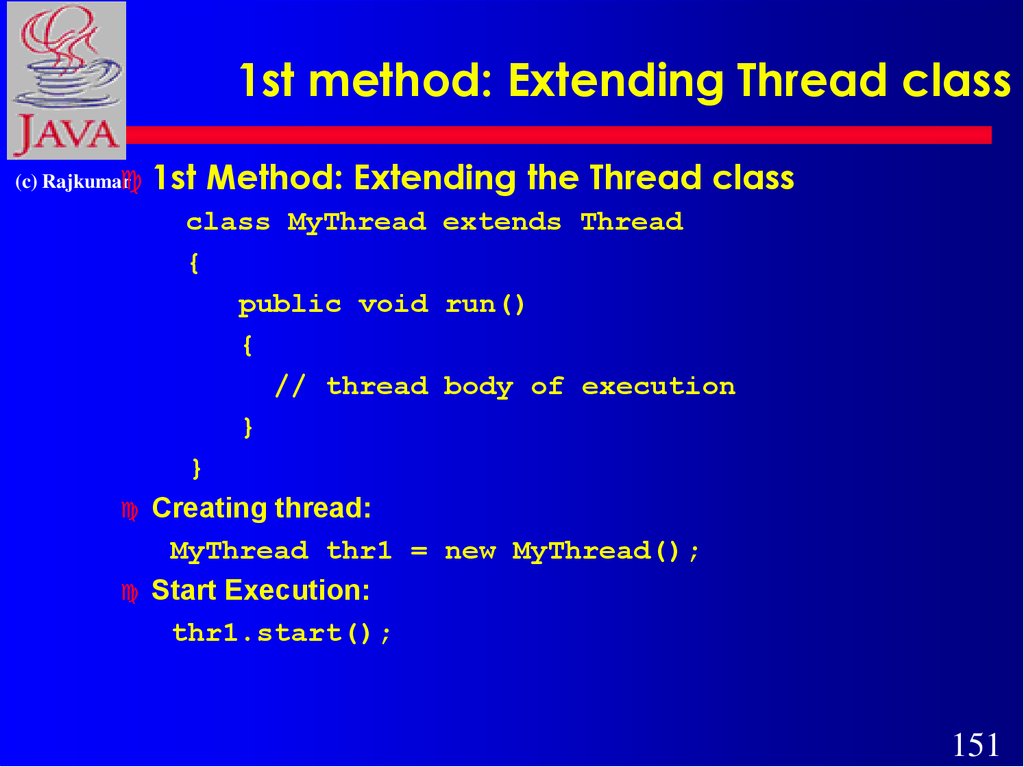
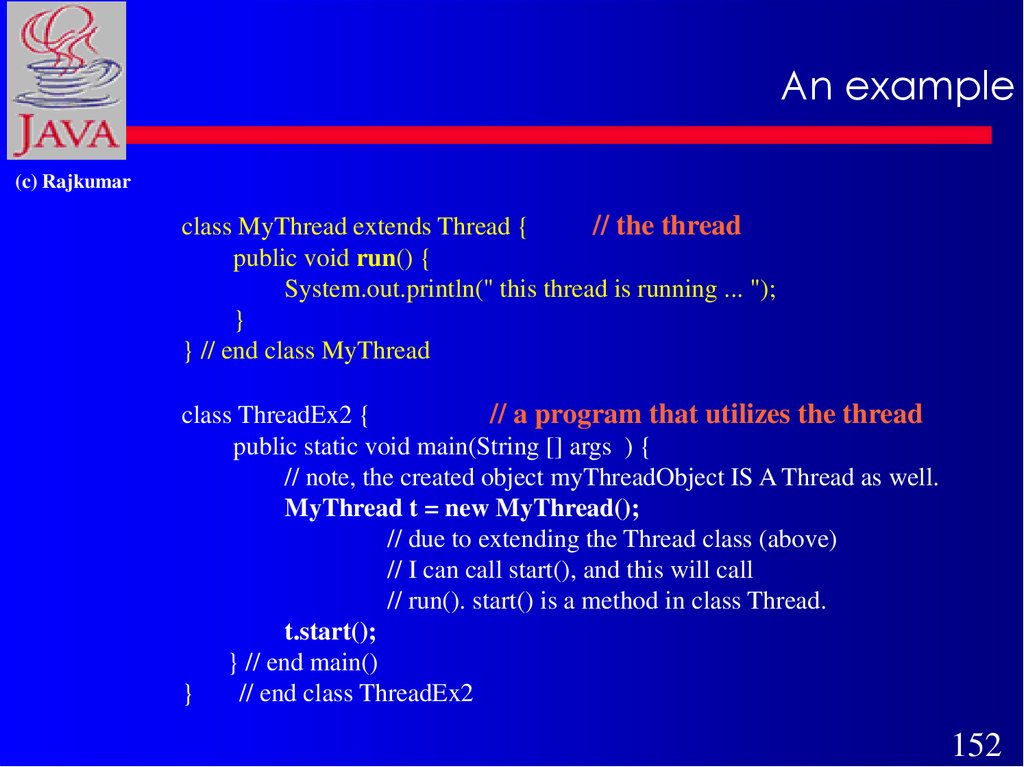
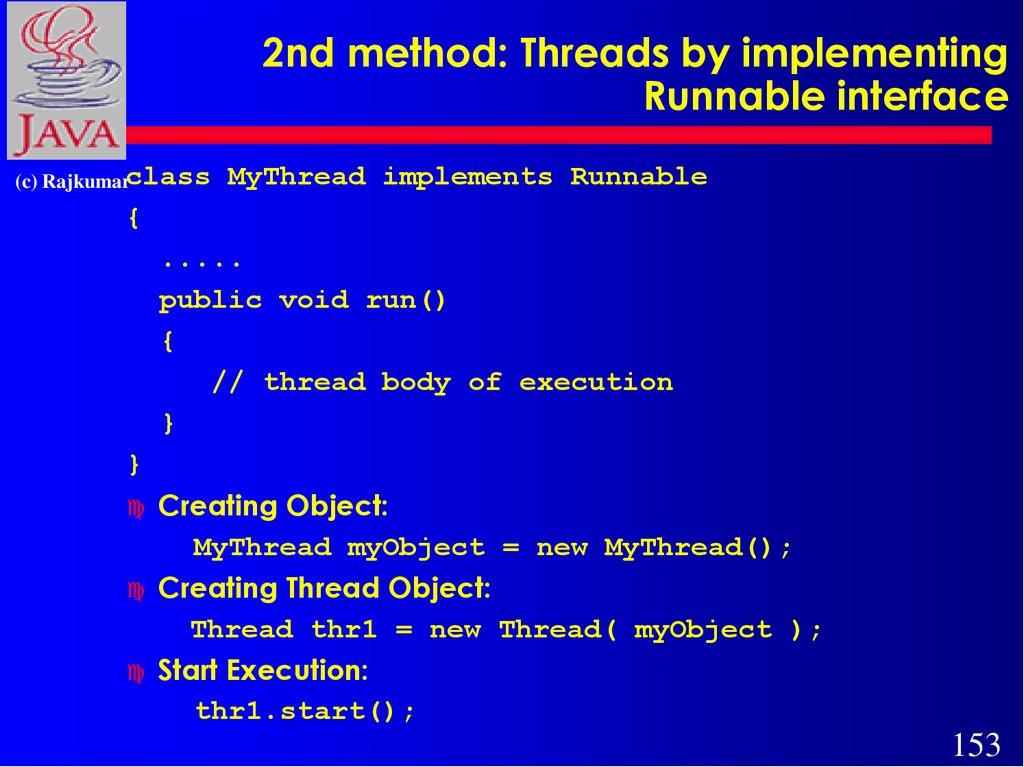
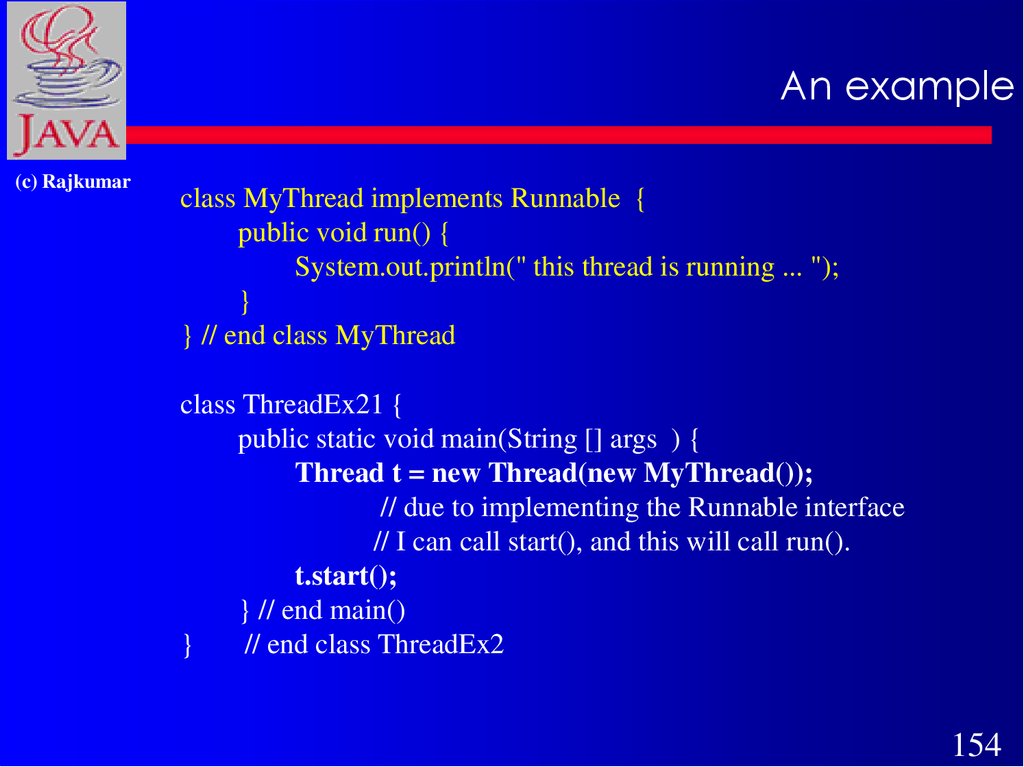
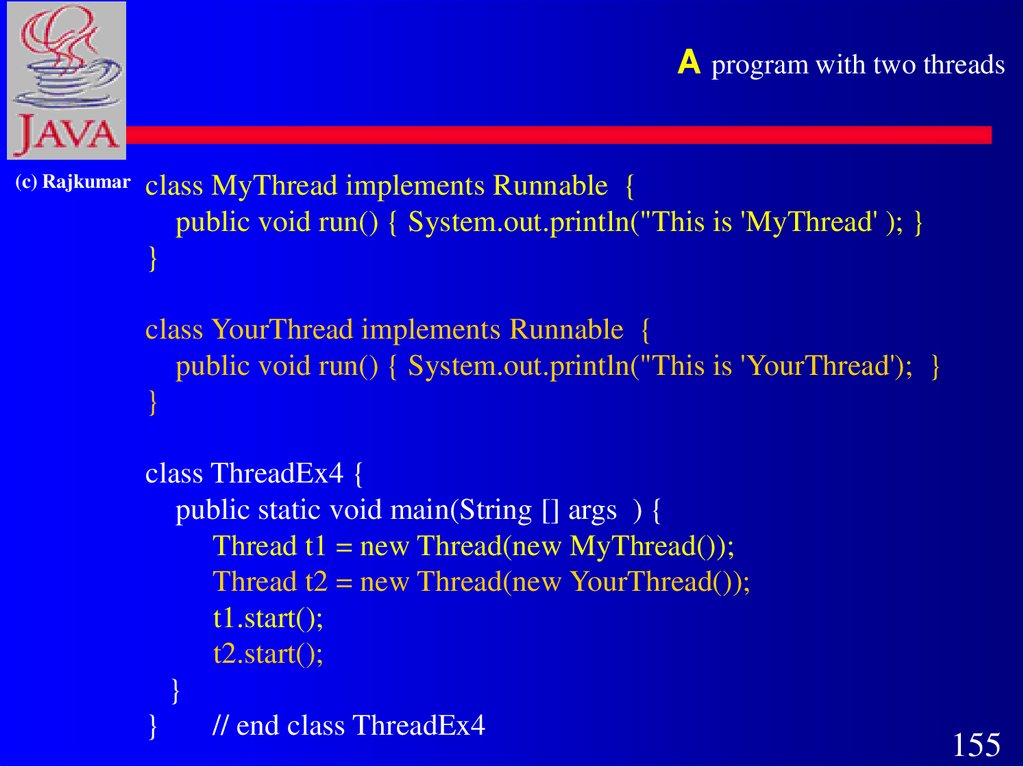
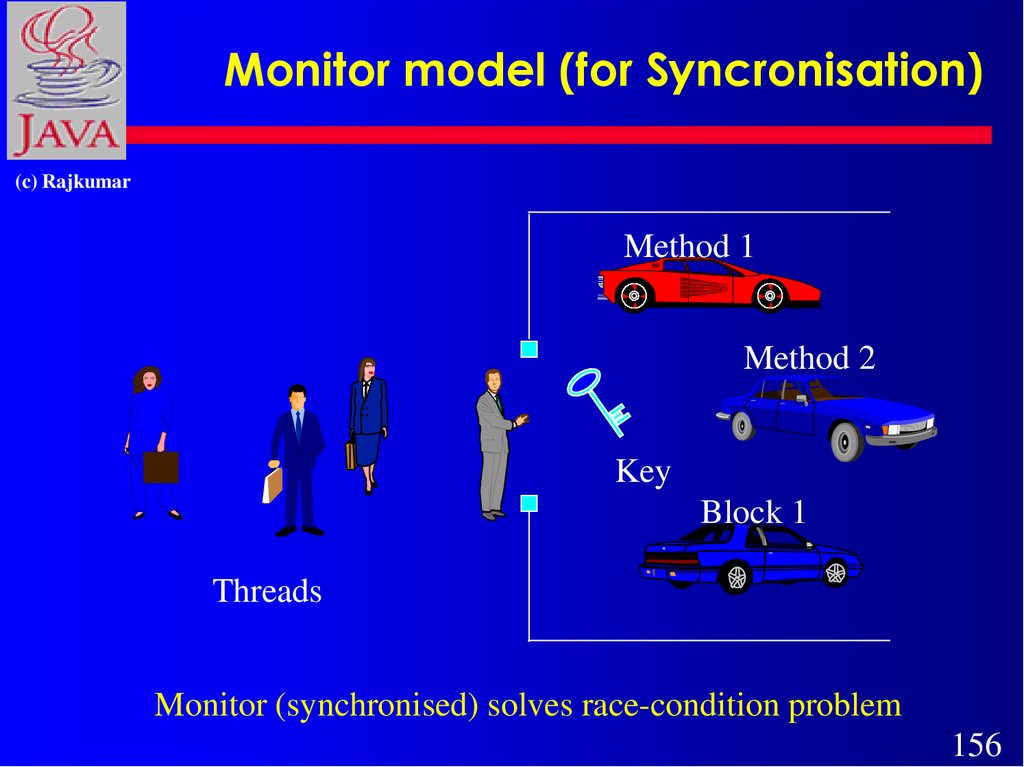
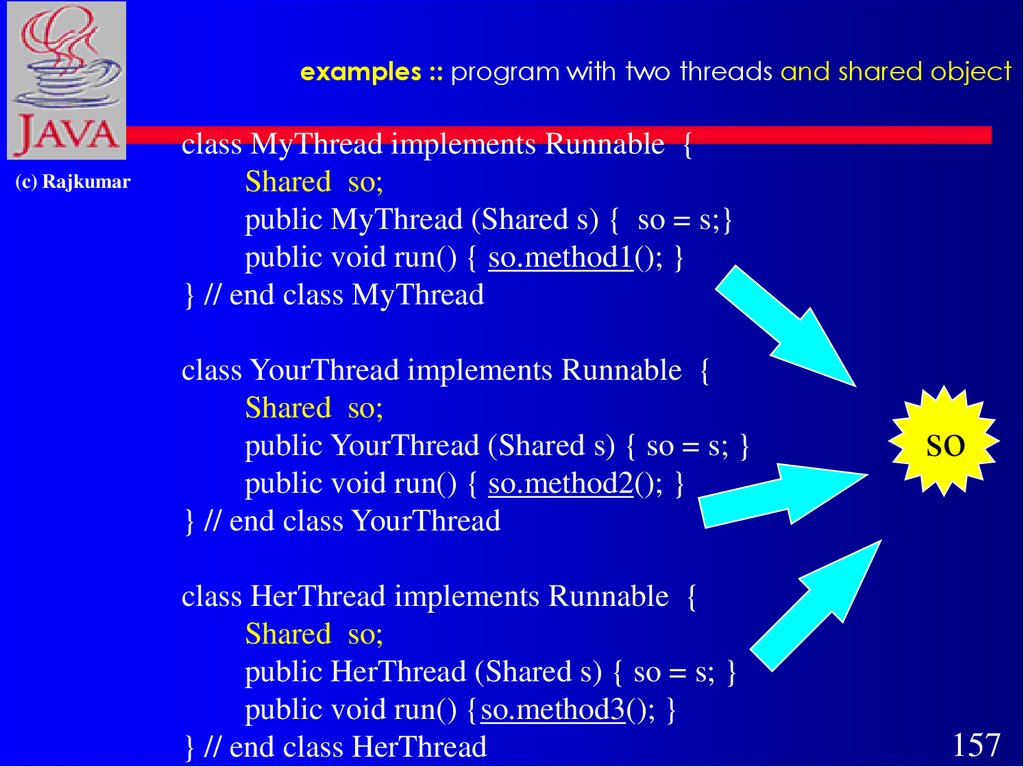

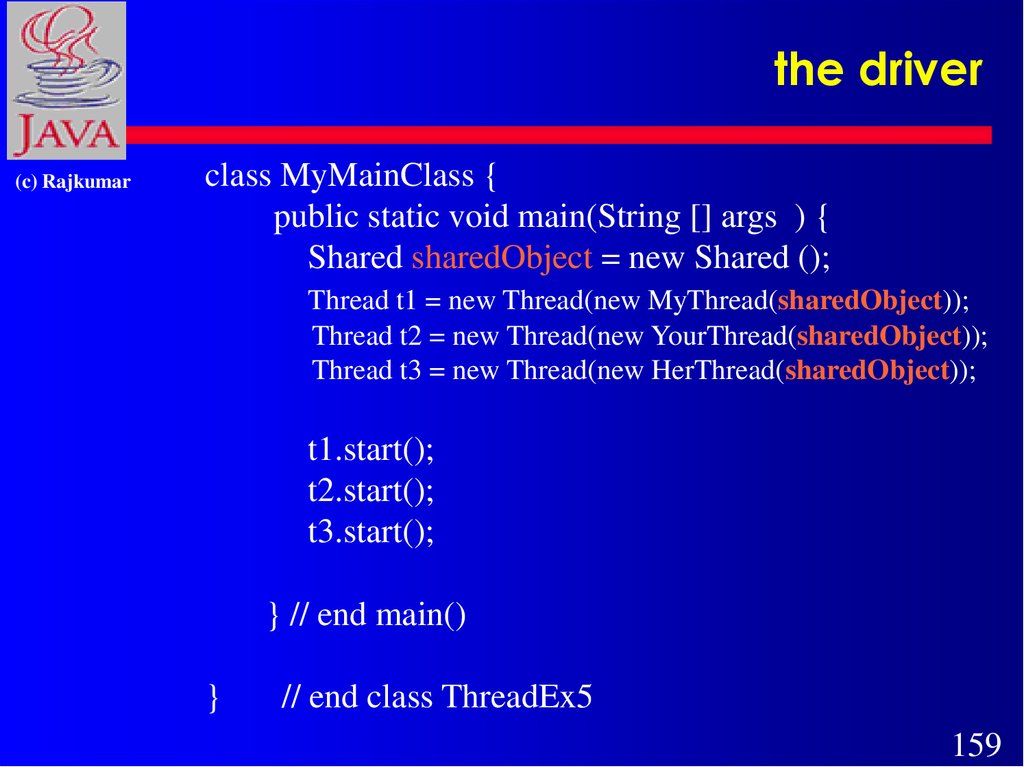
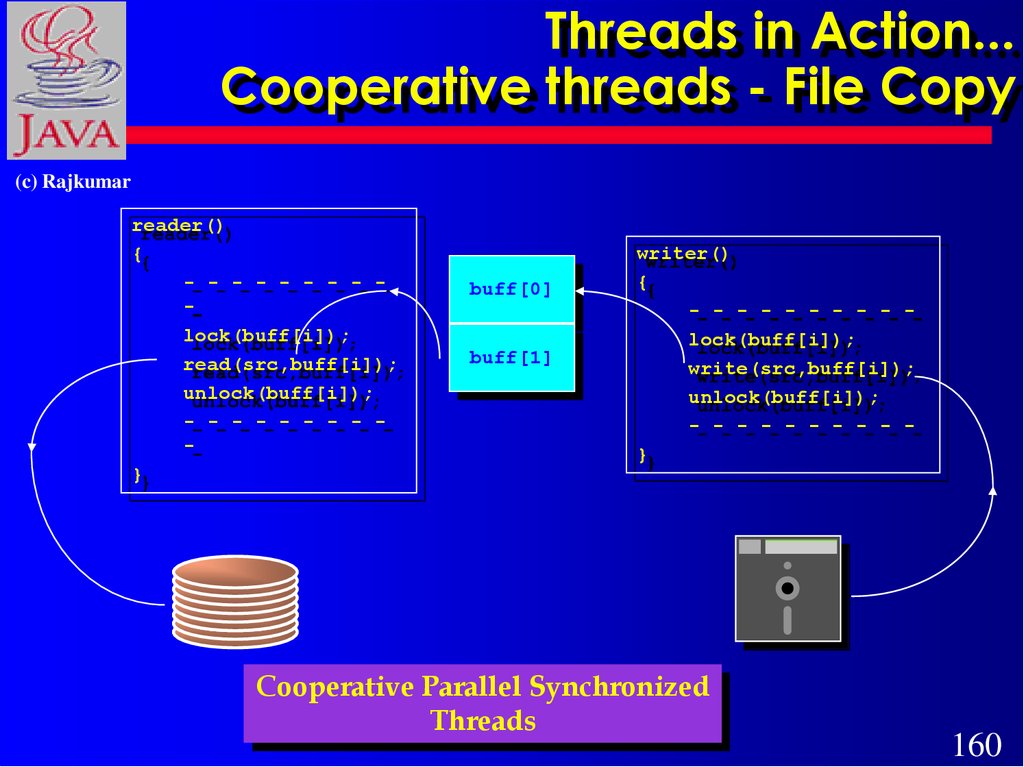
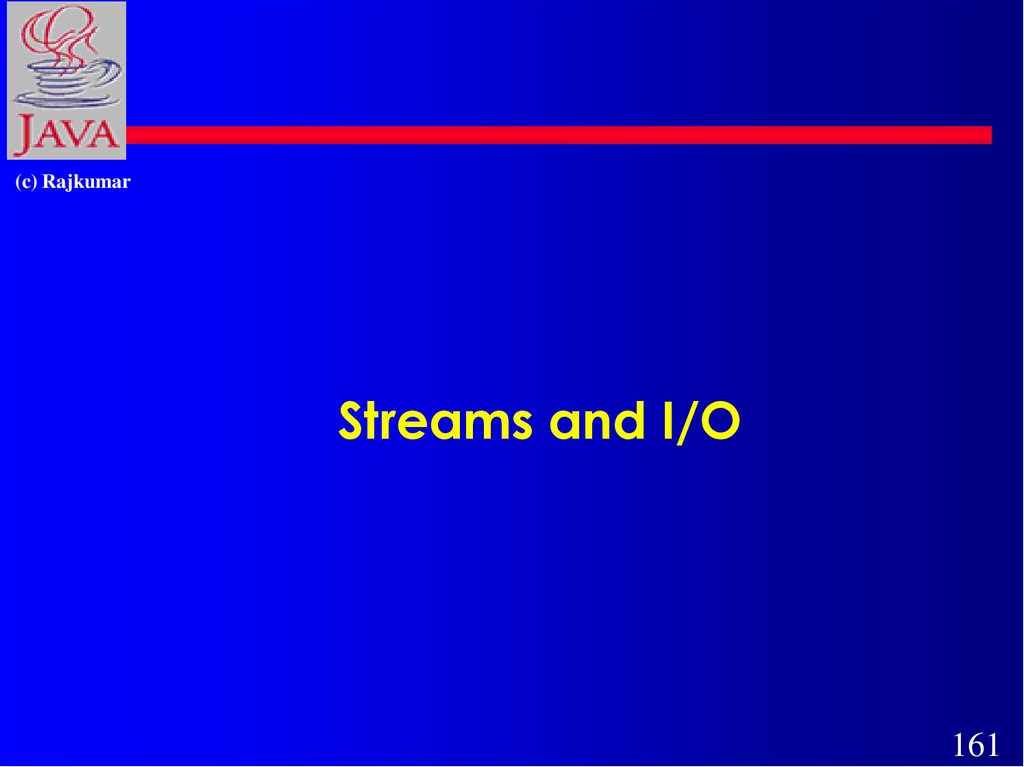
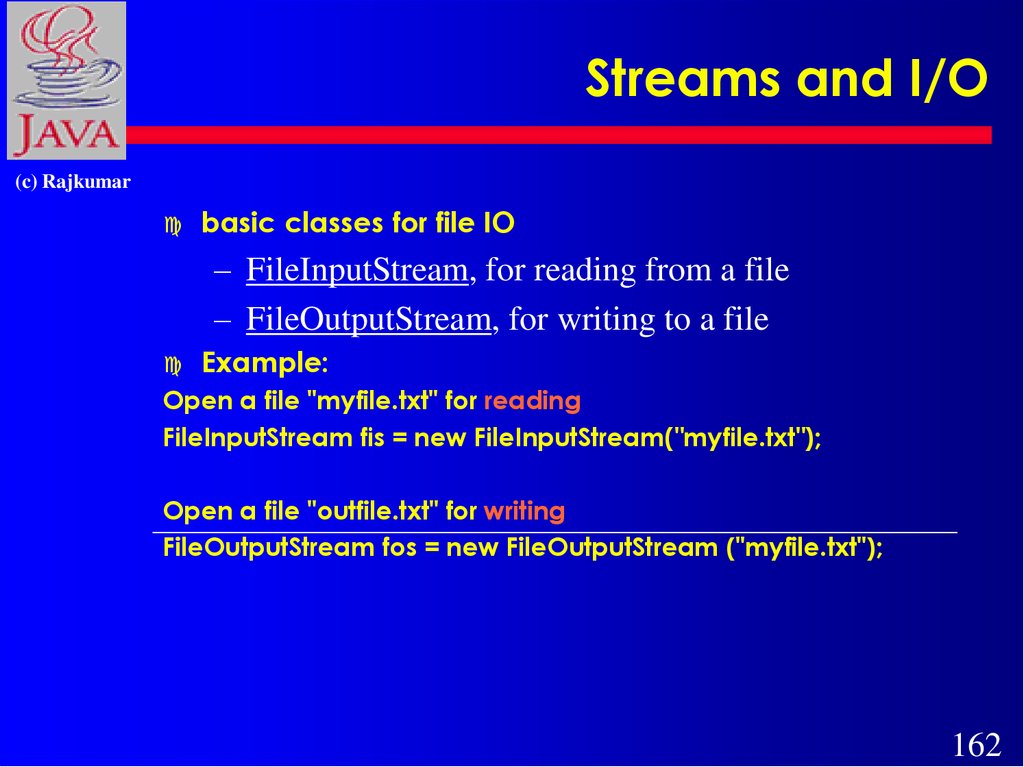
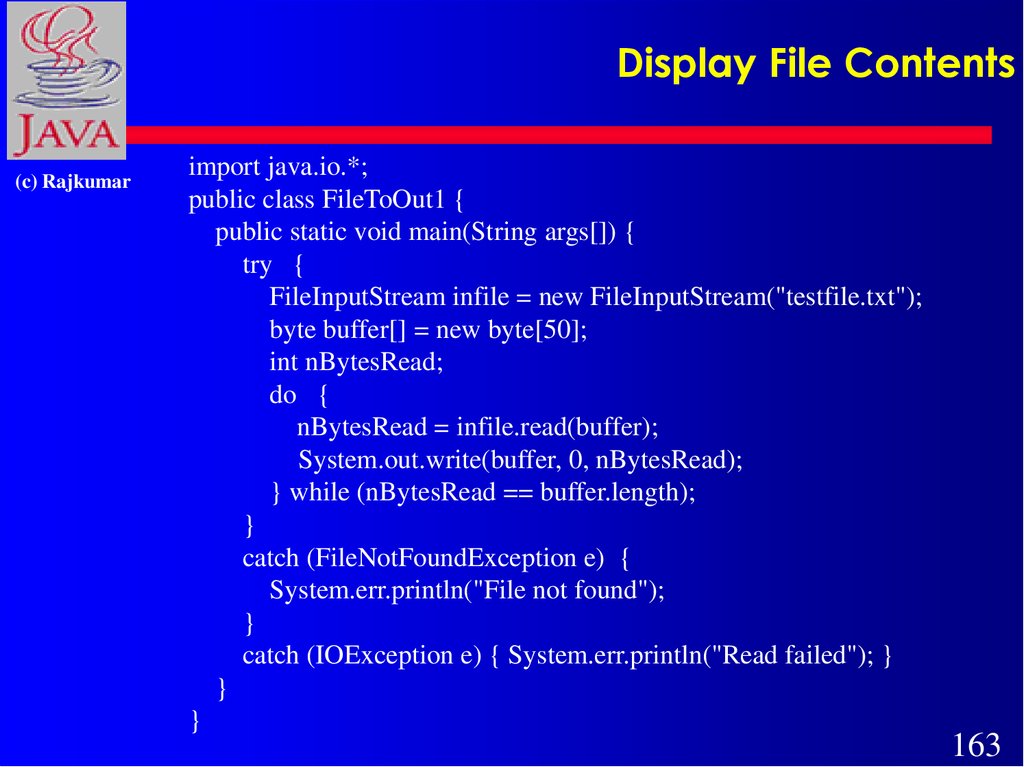
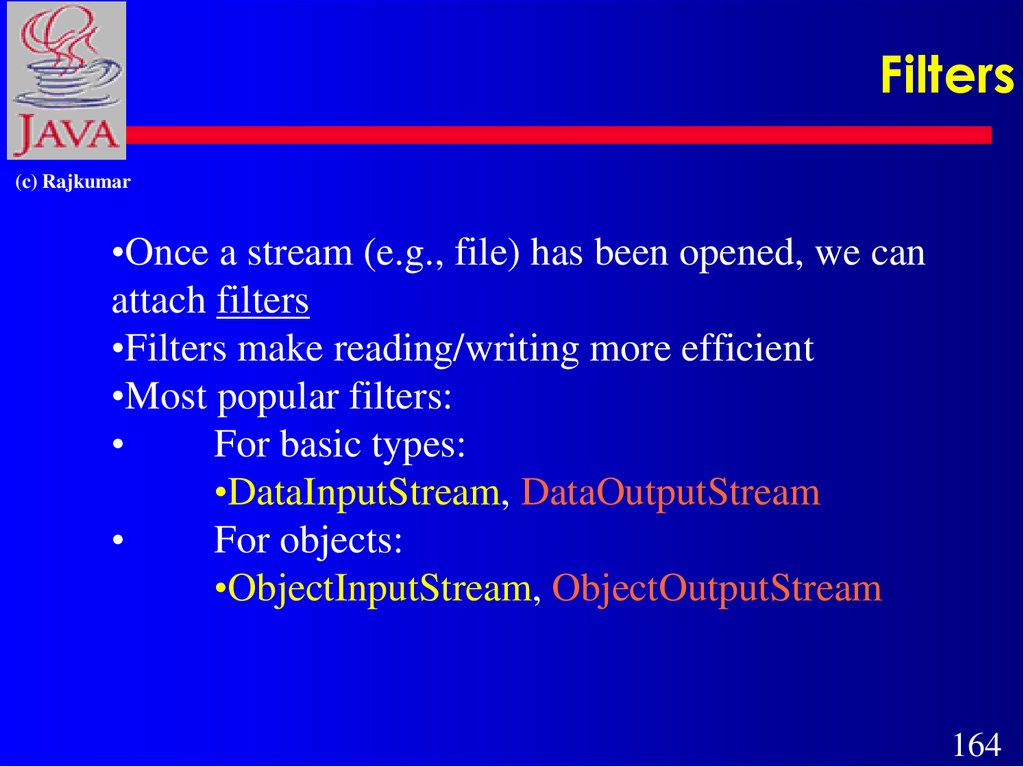





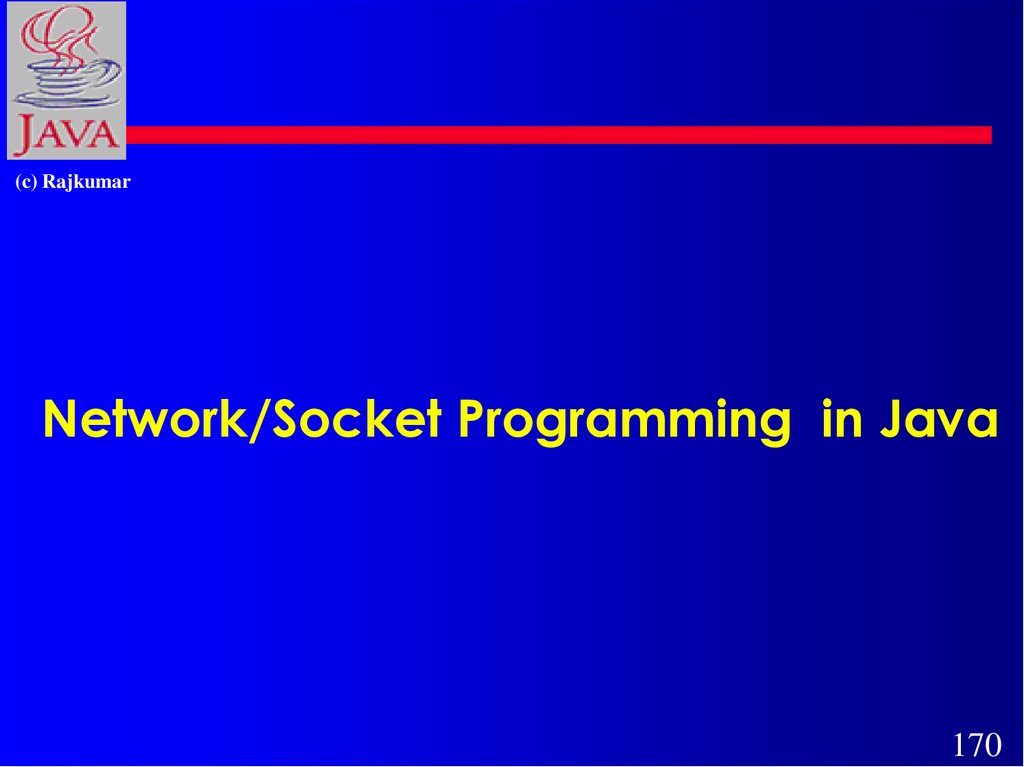

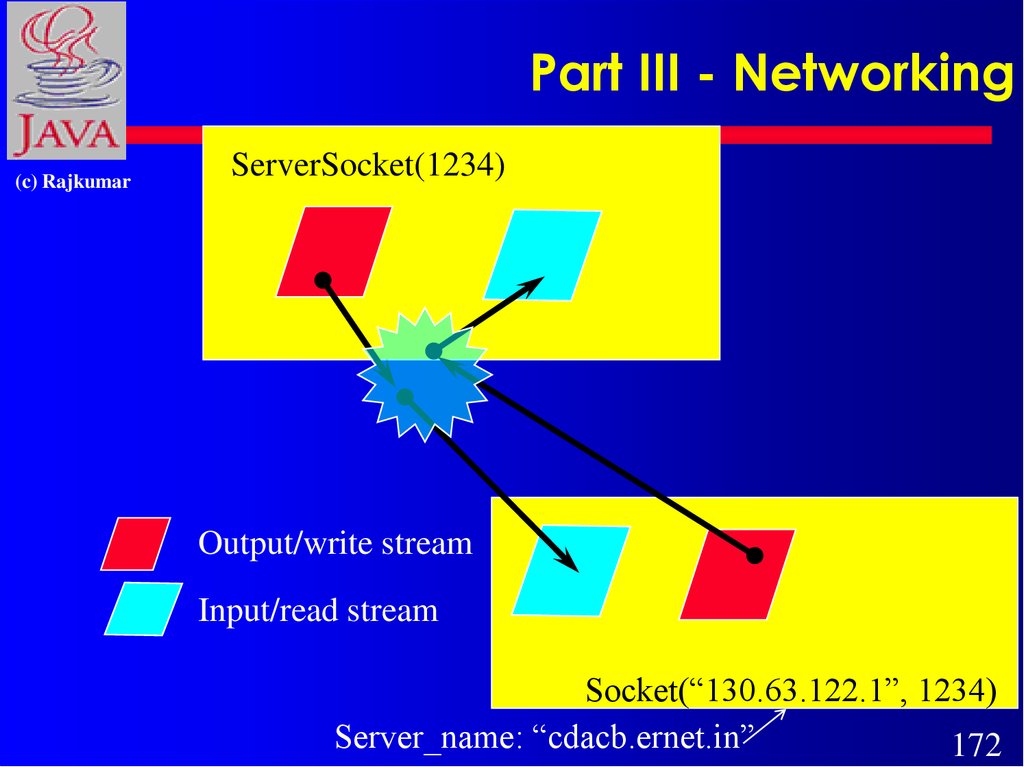

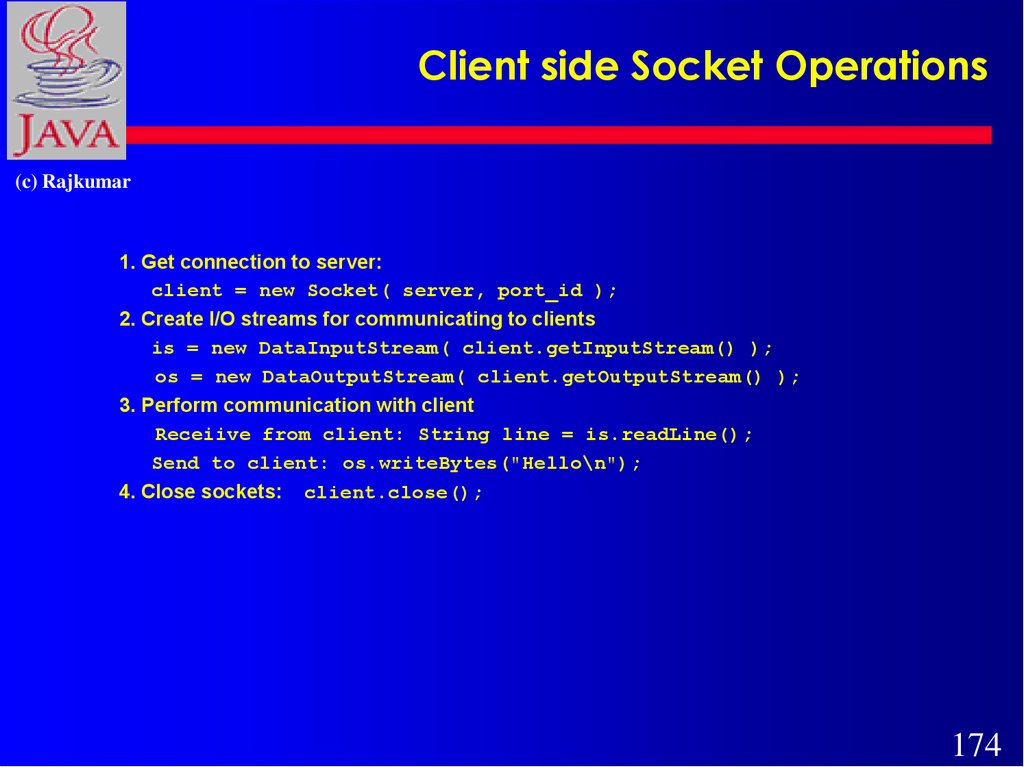
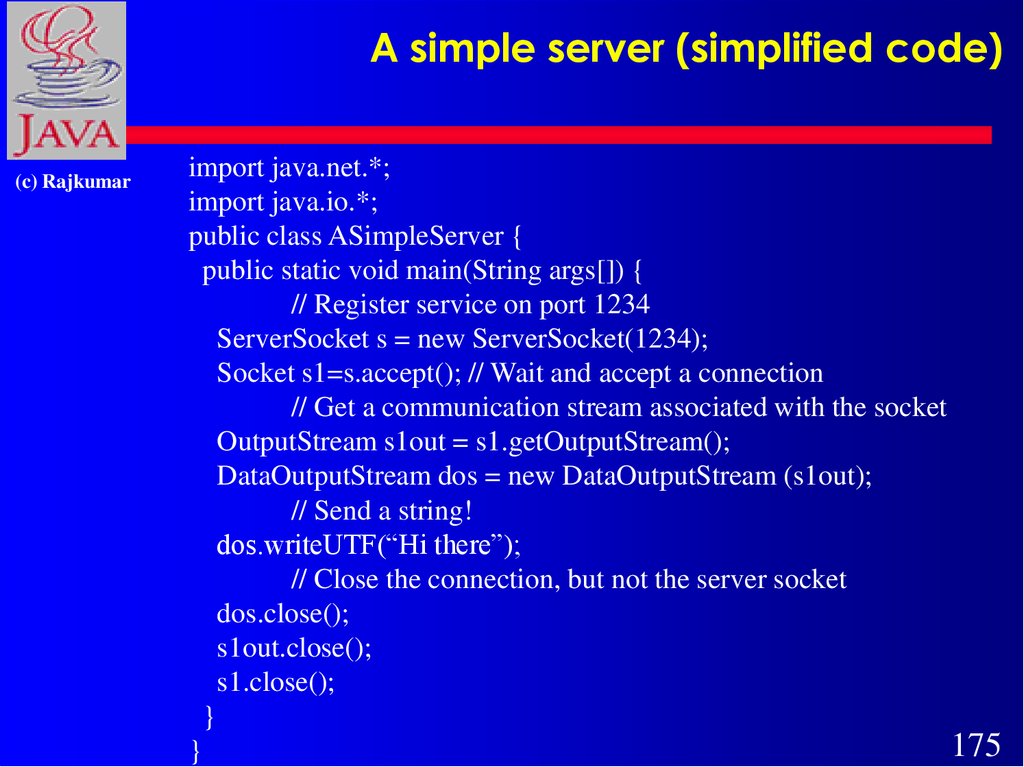

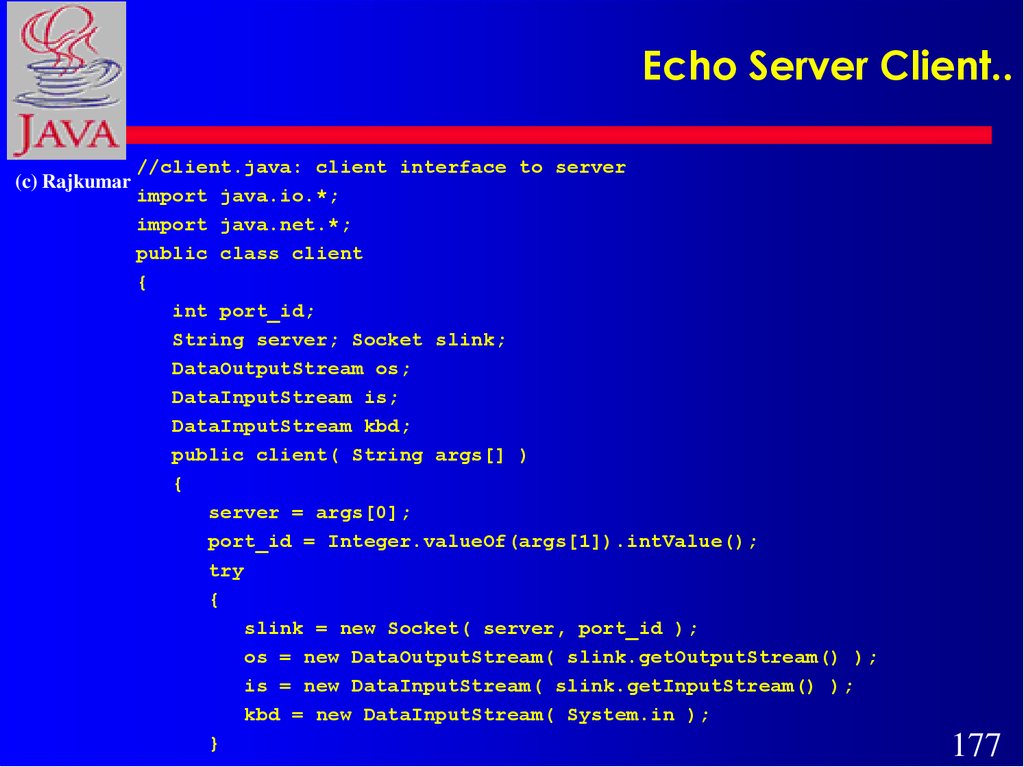

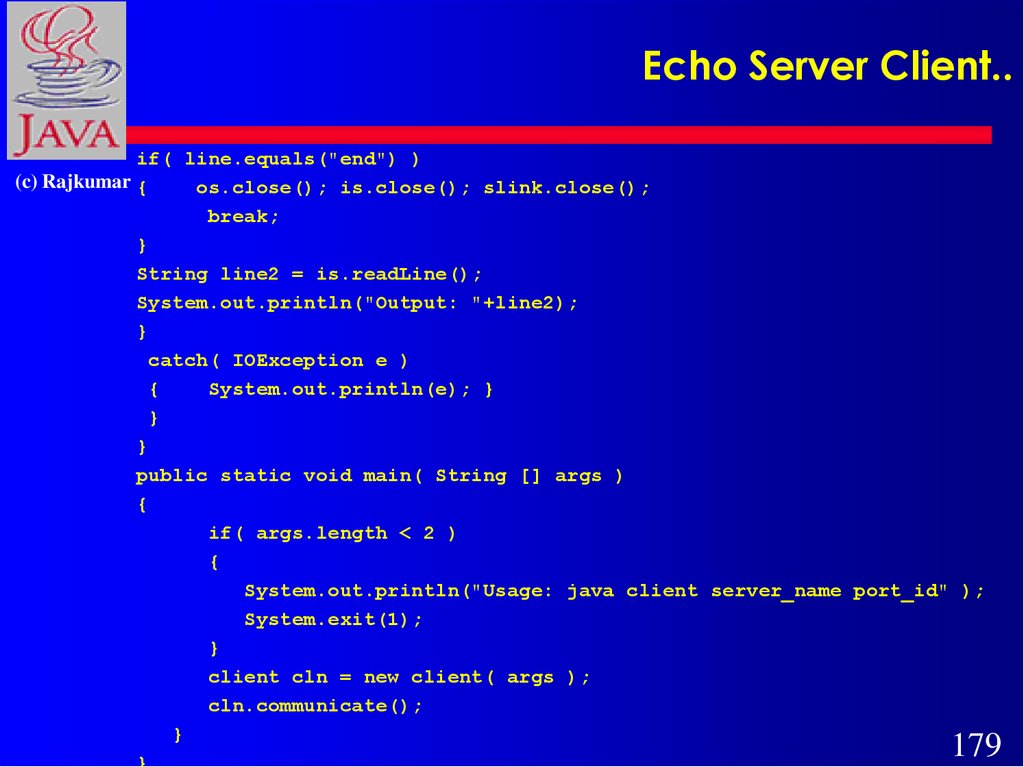
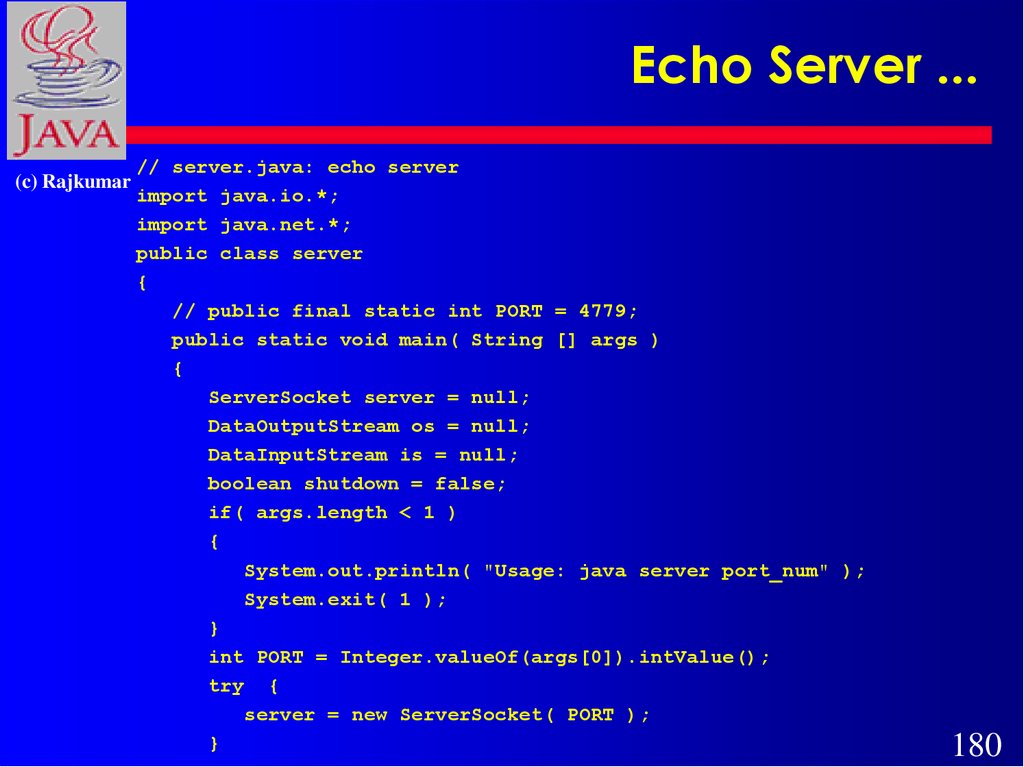
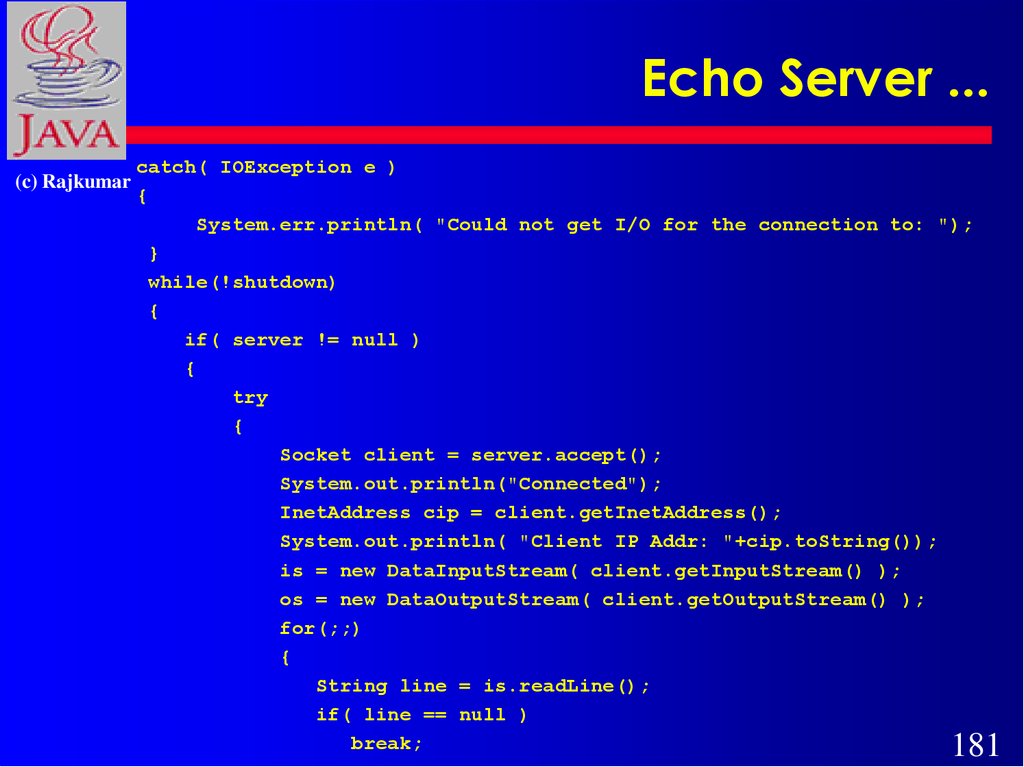
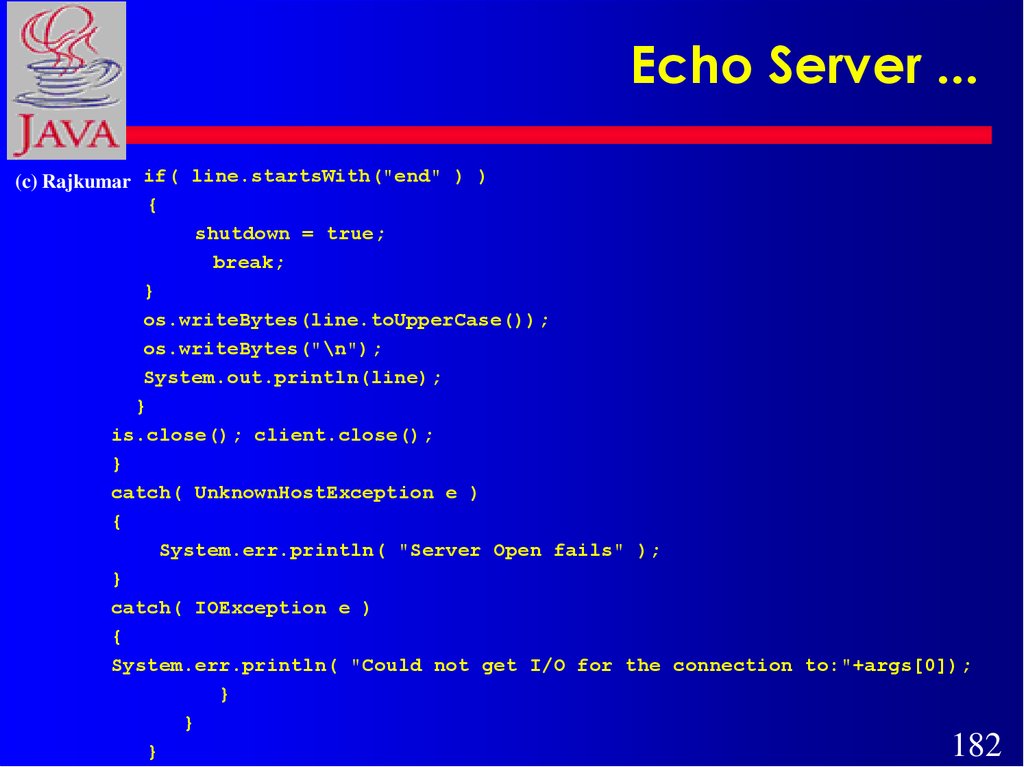
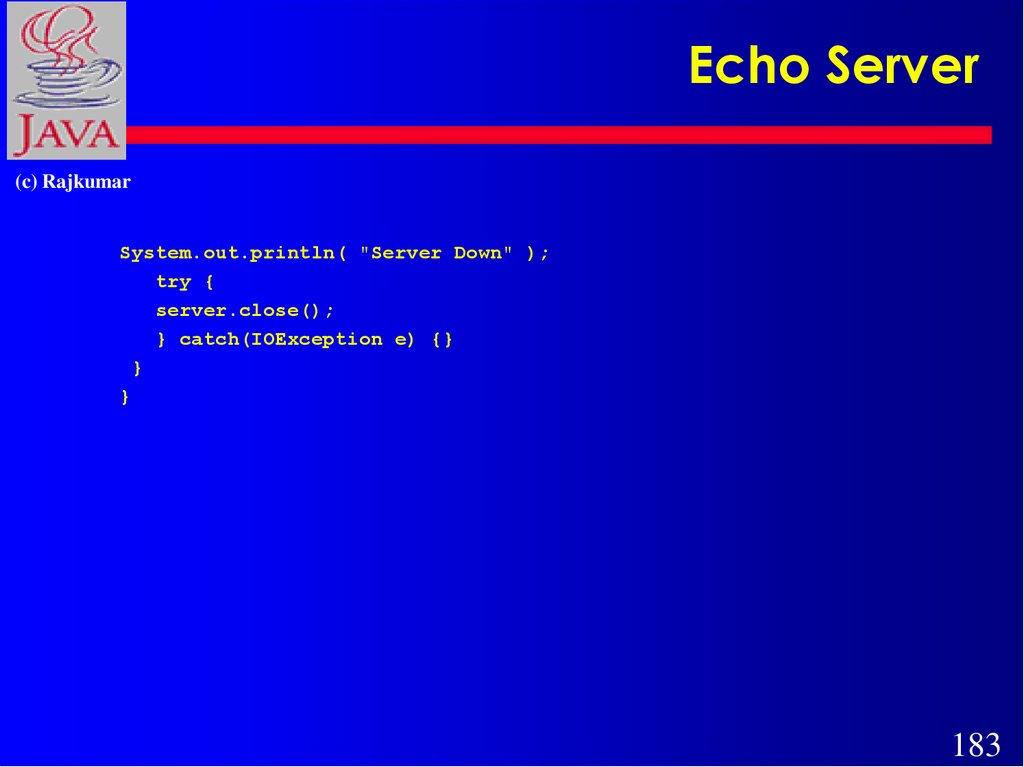
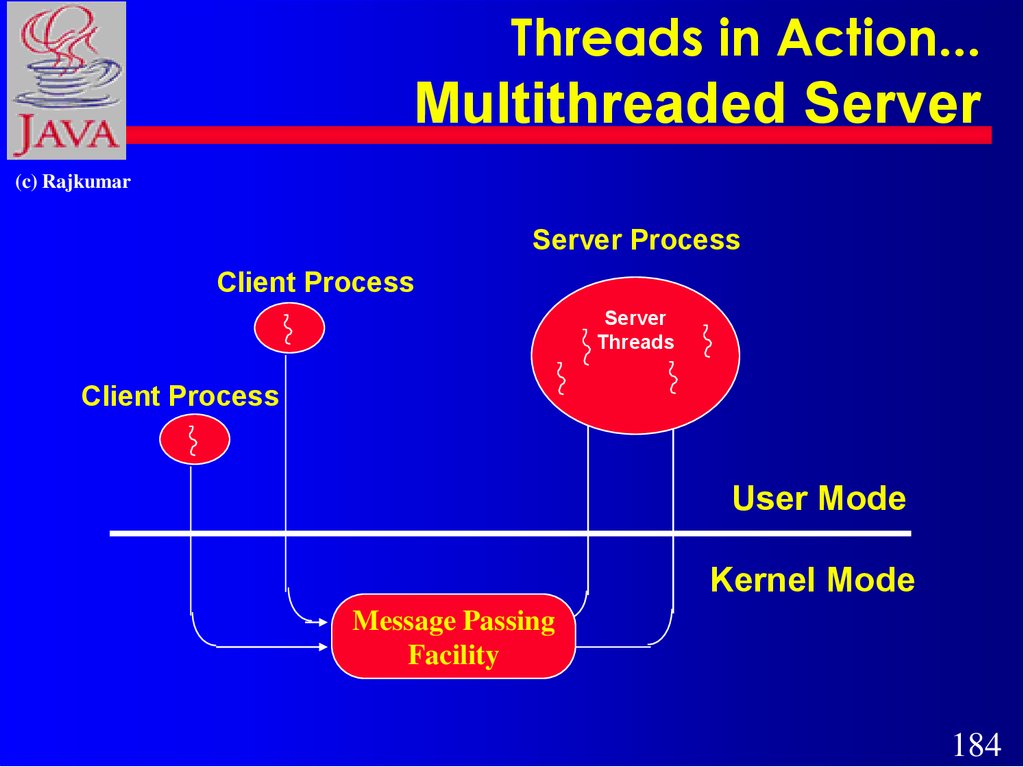
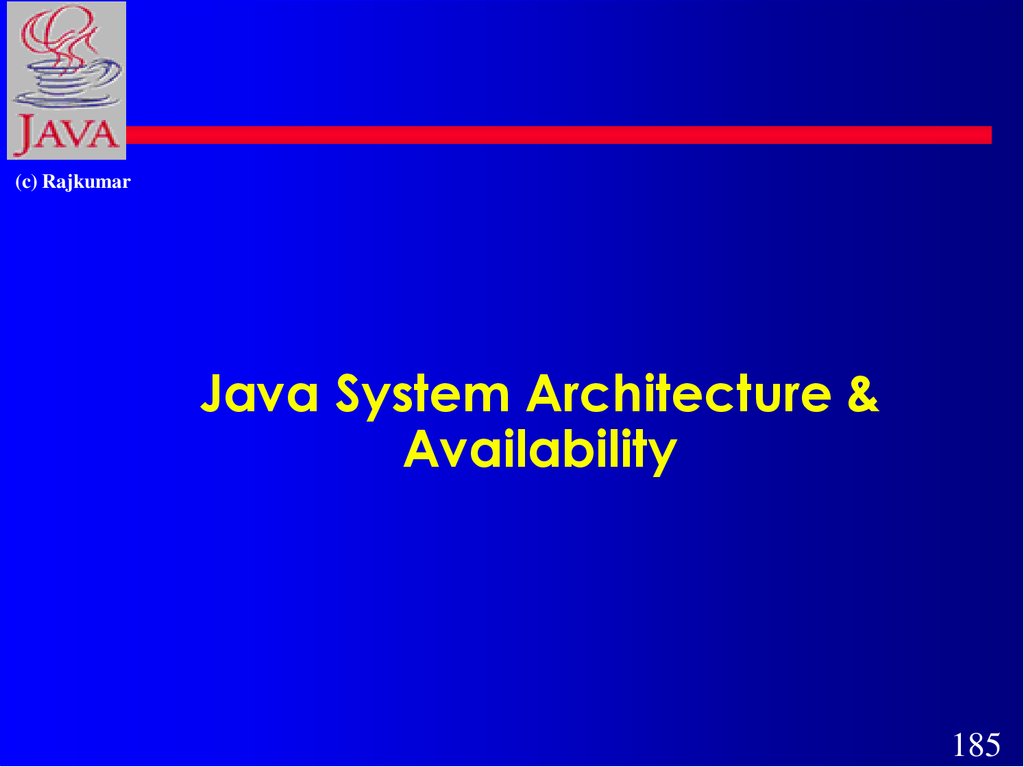
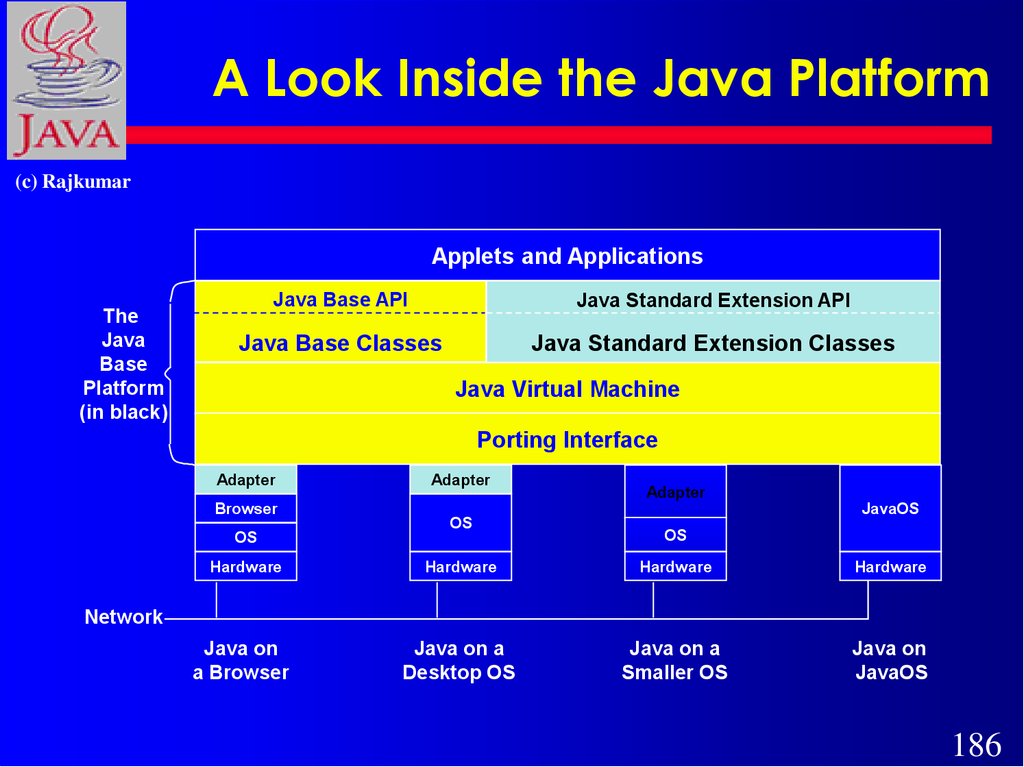
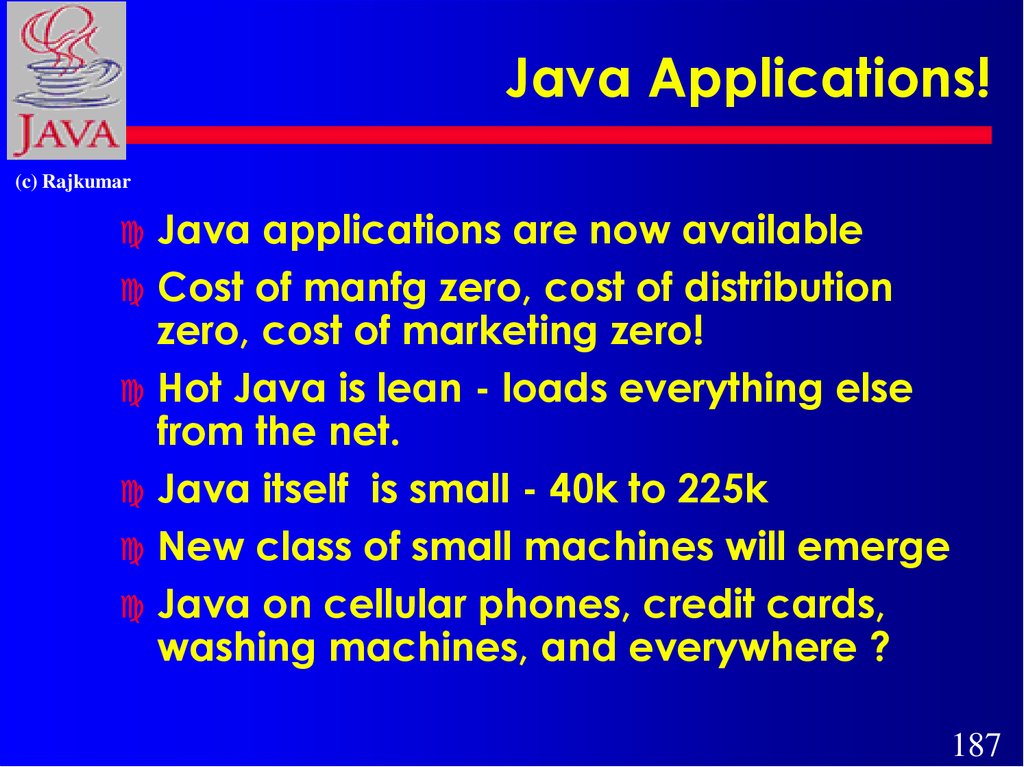
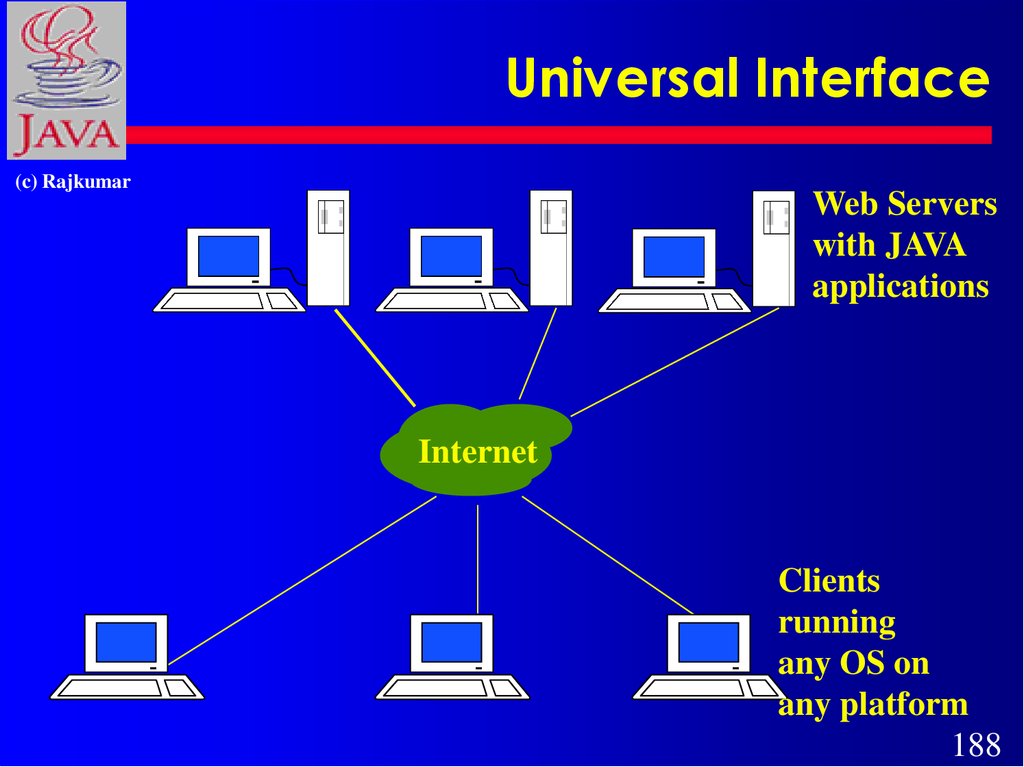
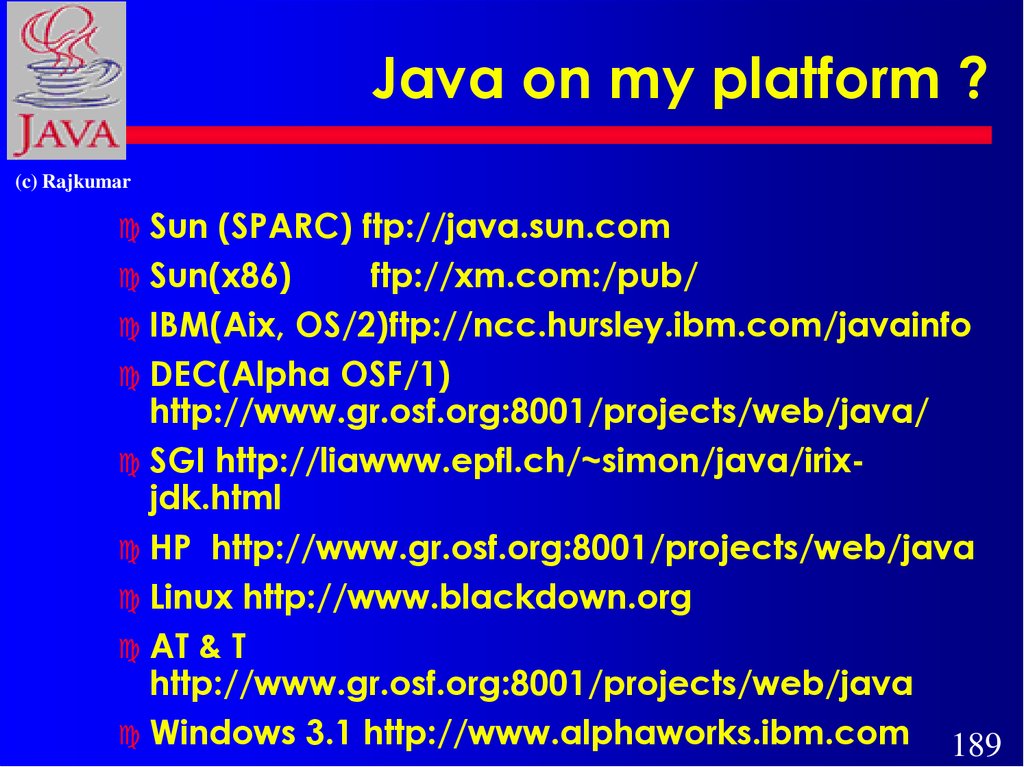
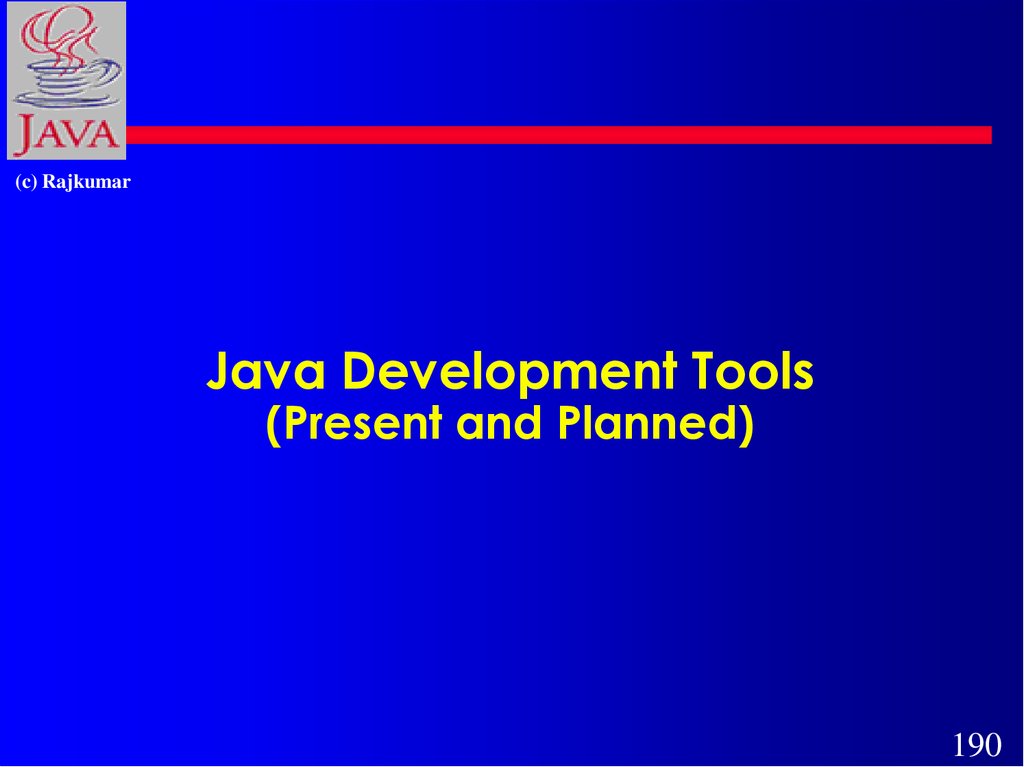
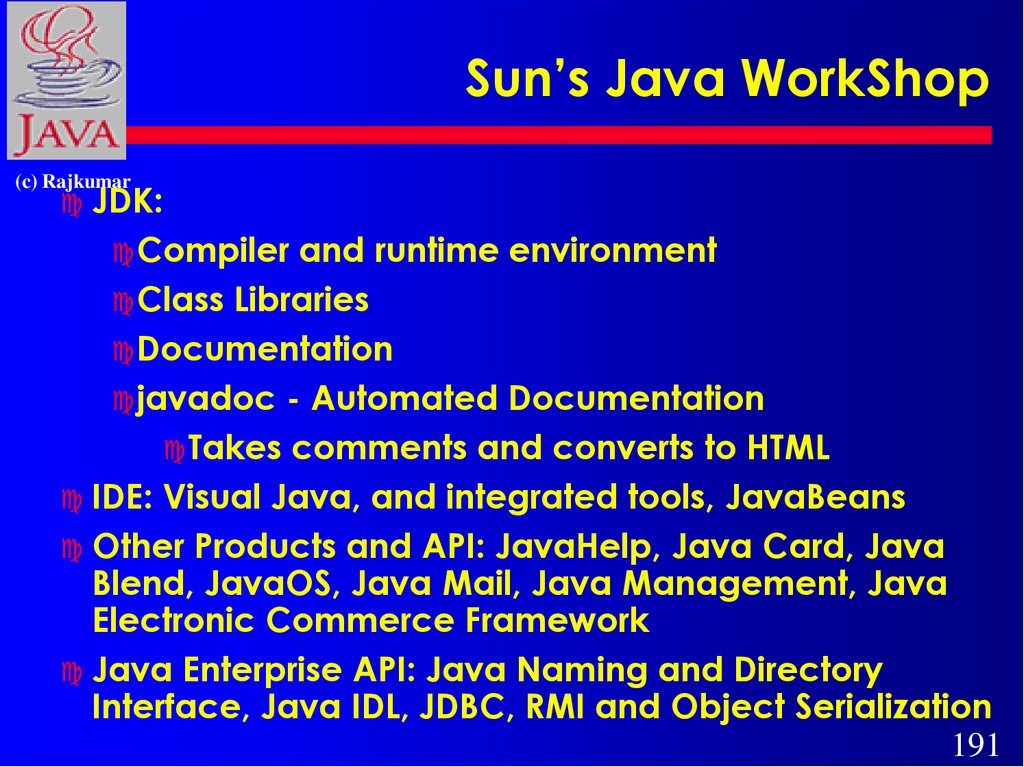
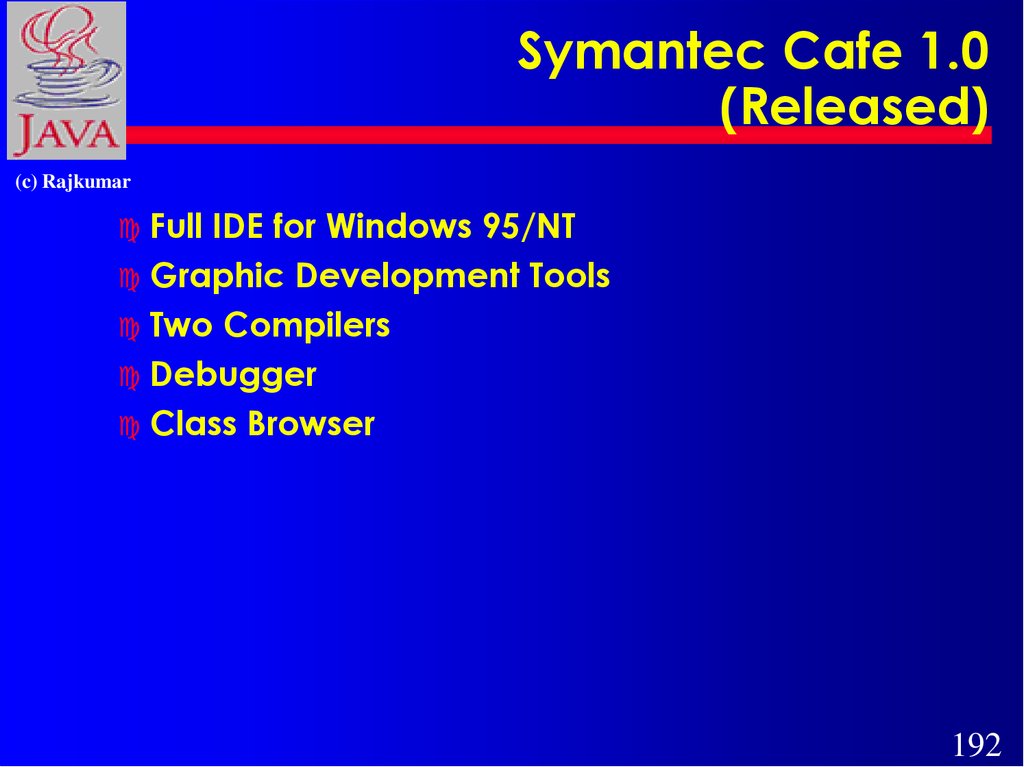
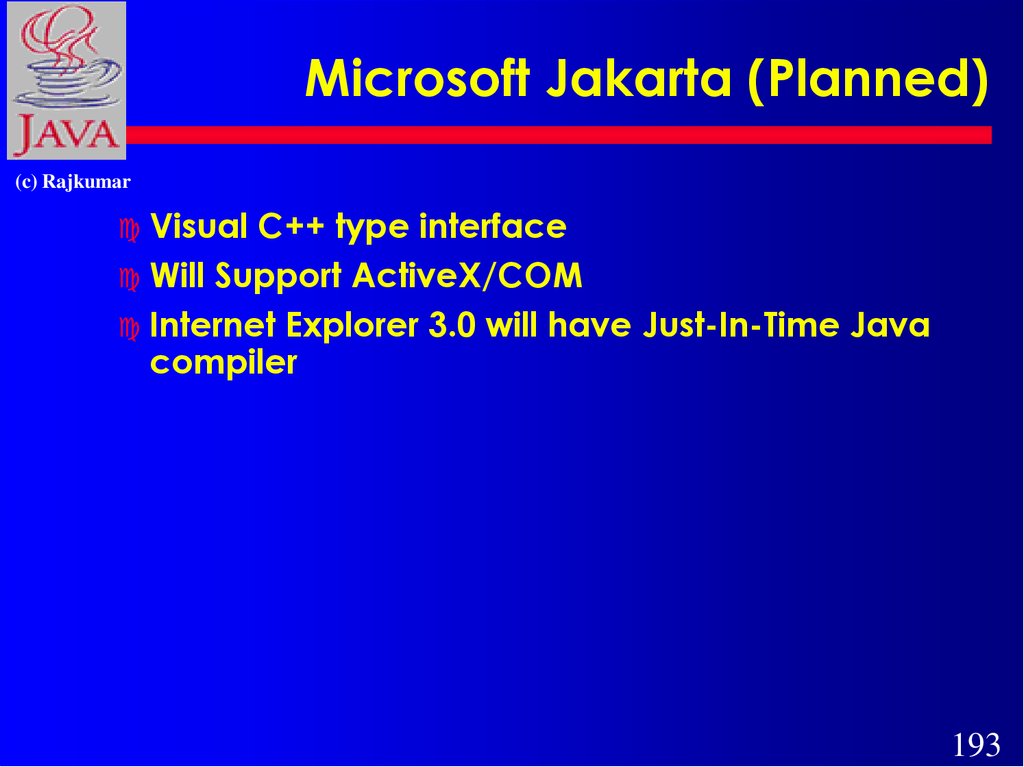
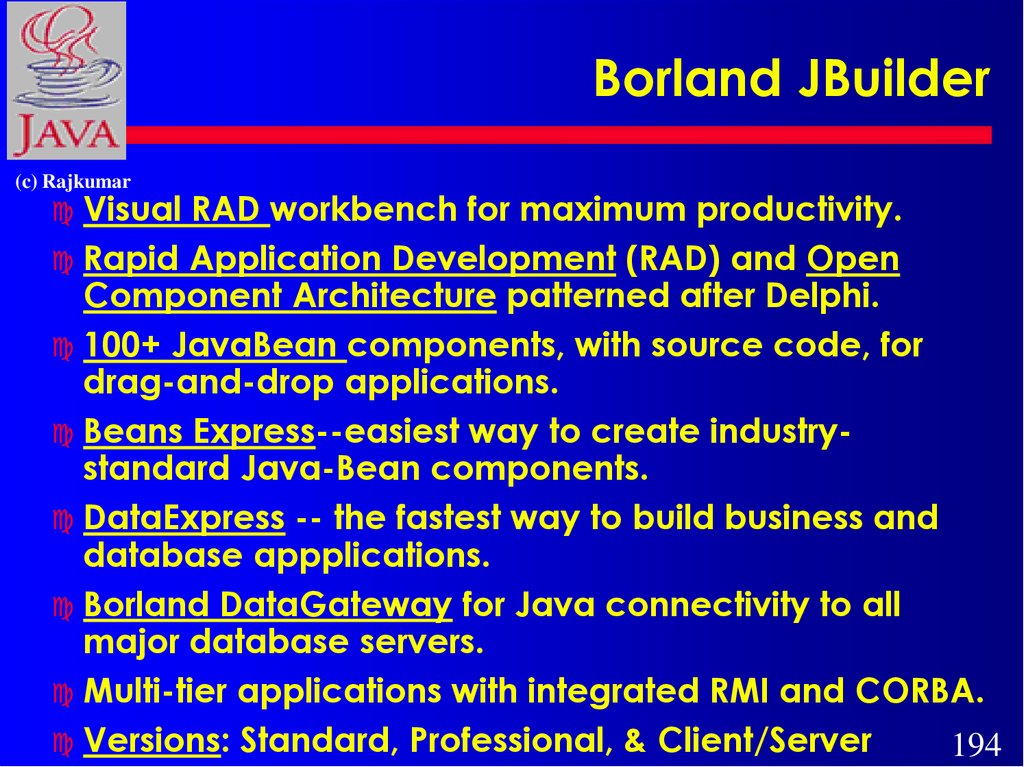
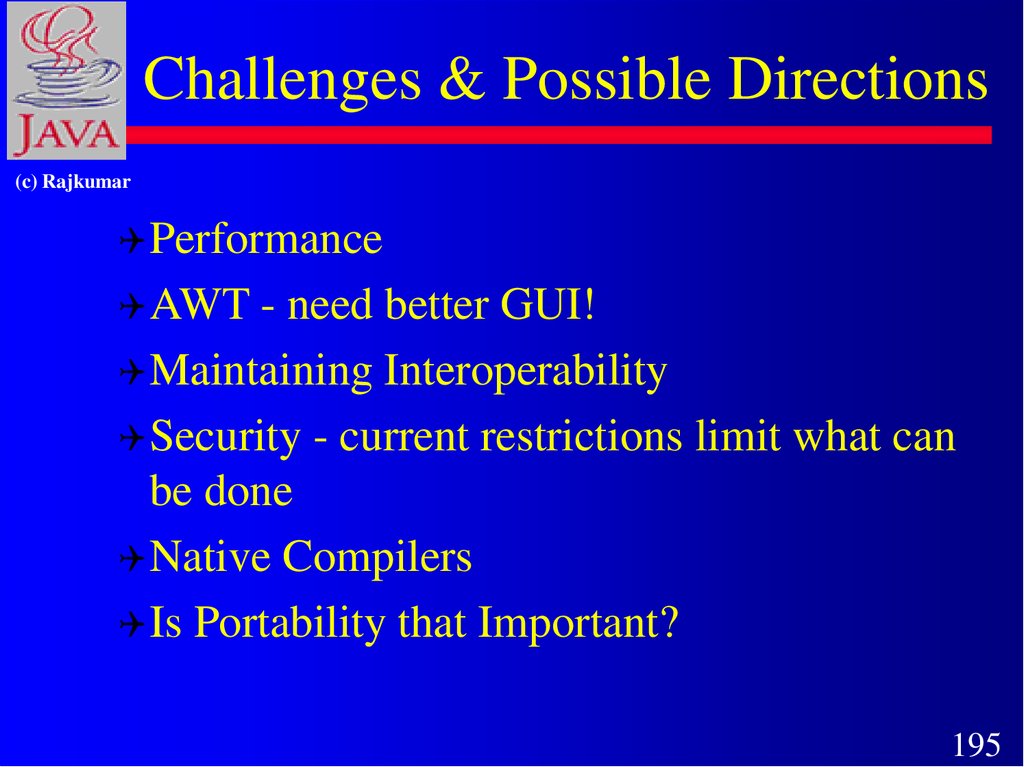
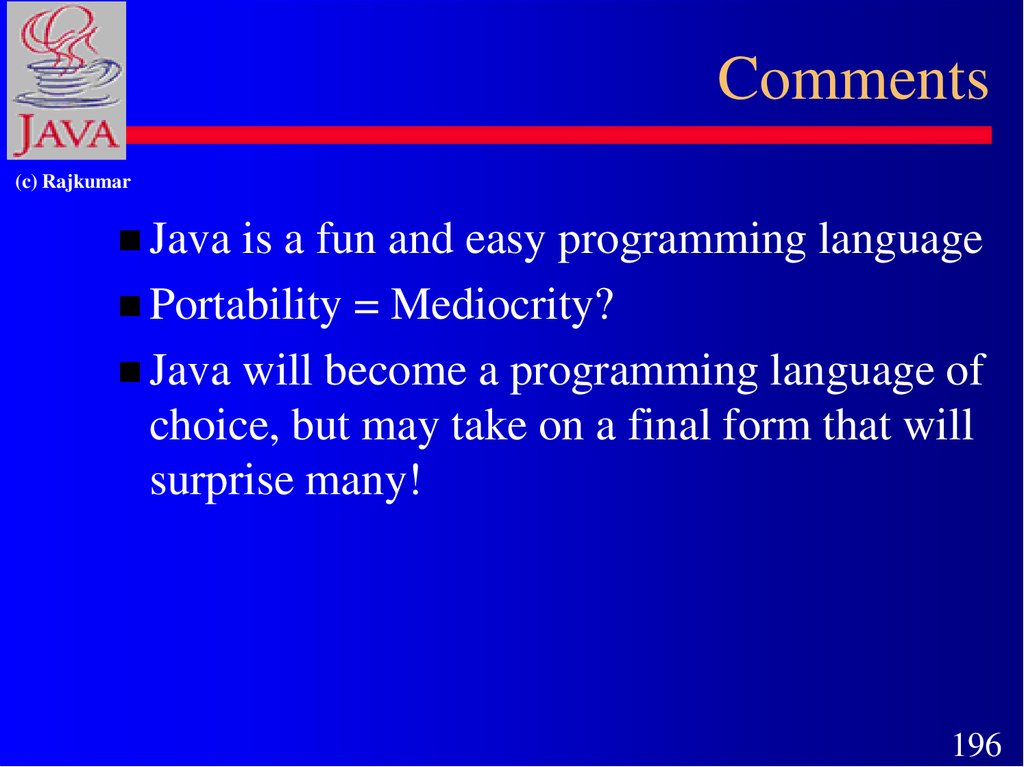

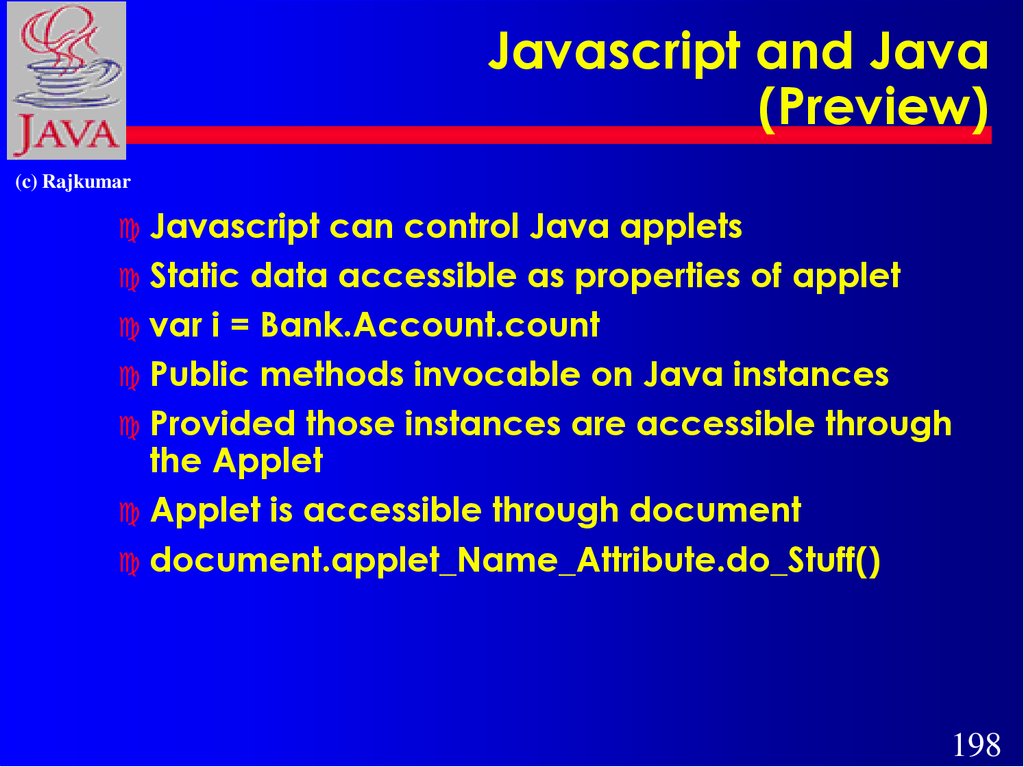




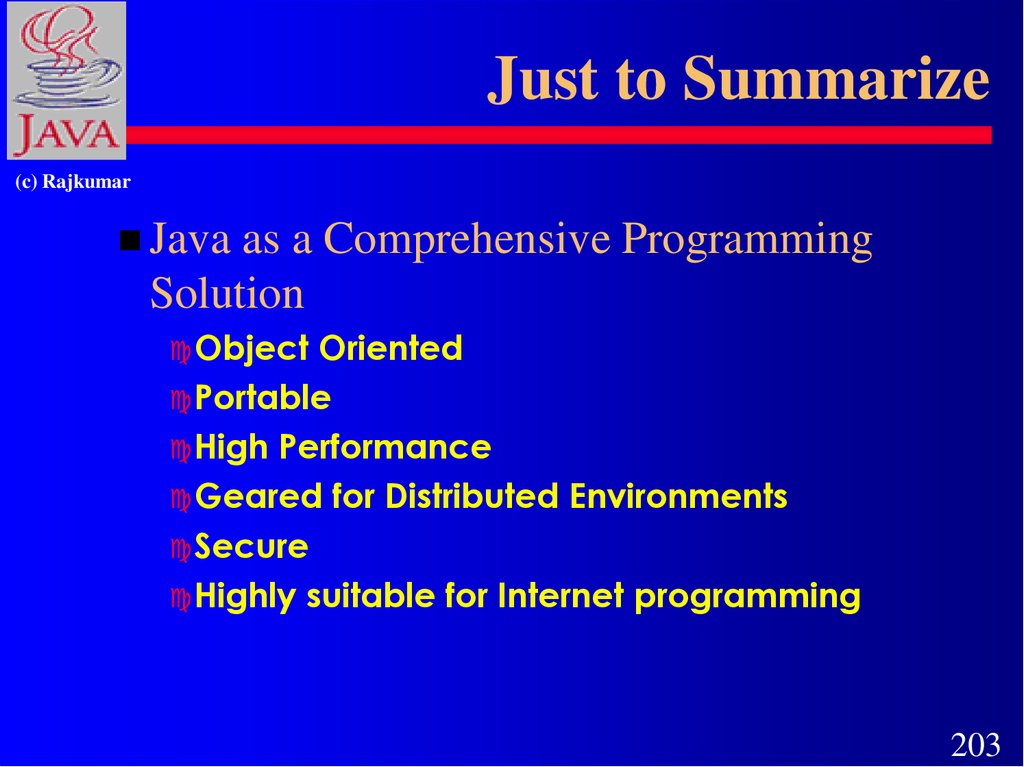


 programming
programming








